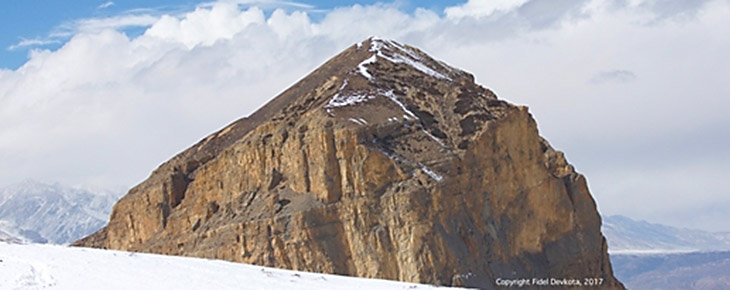
August 2017
John Vincent Bellezza
Welcome to the 11th anniversary issue of Flight of the Khyung, the 133rd to appear since 2006! This month’s offering is all about Mustang, that legendary kingdom nestled high in the Himalaya of Nepal. The featured article introduces ancient rock paintings and inscriptions recently discovered by Dr. Fidel Devkota, a Nepali researcher who has worked extensively in Mustang. This work is co-authored by Devkota and myself. Please continue reading for the latest strides in the study of early Mustang.
Obscured for Centuries: The Lost Rock Art of Lo Mustang
Fidel Devkota and John Vincent Bellezza
Part 1: Cultural-historical background on recently discovered rock art and inscriptions in Kya and Ludak
Fidel Devkota
General introduction
Rock art was recently discovered in the eastern part of Lo Mustang (Glo Smos-thang), a region known as Shar-ri (Shar-ris/Shar-ri), now lying in the newly formed Dalomeh Village Council.* This paper analyzes the contents of this rock art, and its relationship to the people and places of the region in a historical context.
Dalomeh corresponds to the lower part of Lo Mustang (Upper Mustang). Since 2015, Nepal has been divided into seven provinces and the Mustang district lies in Province No. 4, defined by Schedule 4 of the new constitution (pending further amendment). Dalomeh was declared a Village Council before the Local Level Elections of 2017. The former Surkhang, Ghemi, Ghiling, Tsarang, and Marang VDCs were merged to form the Dalomeh Village Council.
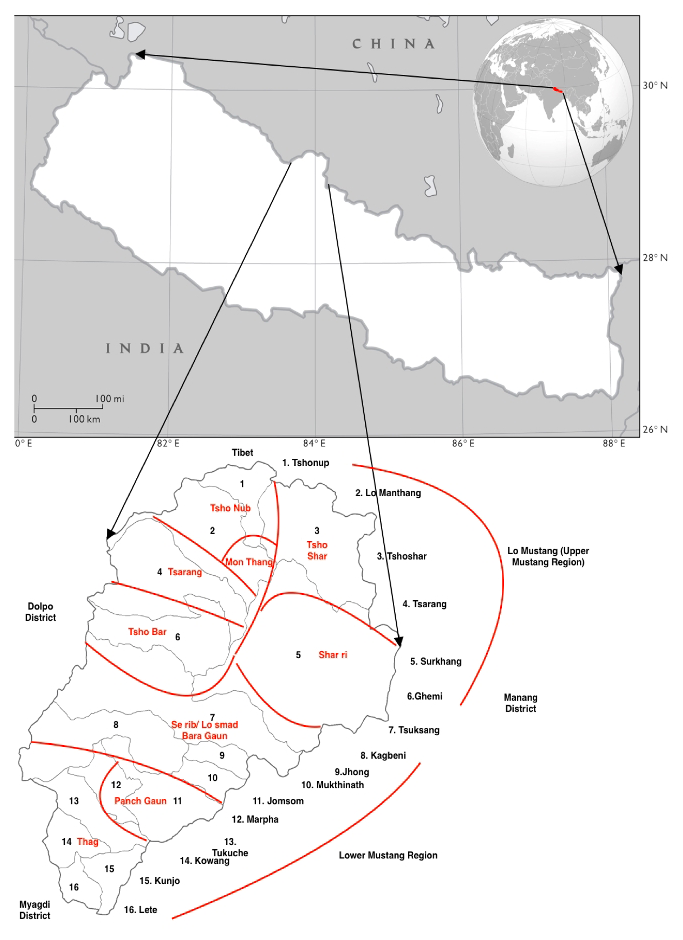
Map of Mustang and its geographic placement in Nepal and the wider region. Includes 16 former VDCs of Mustang District and historical divisions (marked in red) of Lo Mustang and areas under its influence. Map by Fidel Devkota, partially adapted from Dhungel 2002.
The major settlements in Shar-ri are Di, Surkhang, Yara, Ghara, Dhe, and Tangya. Shar-ri (or the former Surkhang VDC) has a unique cultural heritage in Lo Mustang. The Mustang Chu (Mustang River) must have played a vital role in the obscurity of the Shar-ri region,* as cultural and historical developments on the eastern side of the river had less impact on it. For example, the former kingdom of Lo follows predominantly the Sakya (Sa-skya) school of Tibetan Buddhism, which is linked to the foundation of the kingdom when it separated from Gungthang (Gung-thang).† Gungthang was backed by the Sa-skya rulers of Tibet and this sect enjoyed royal patronage with the founding of the Lo Mustang kingdom, its influence remaining to the present day (v. Jackson 1976; Dhungel 2002; Vitali 2012).
Mustang Chu (Mustang River) is commonly known as the Kali Gandaki River. However, in the local geographical and cultural context, the origin of the Kali Gandaki is the confluence called Chusumda, where the Dhe River, Tsarang River and Mustang River meet. The Kali Gandaki may have gotten its name because of the dark water (Nag-po chu) flowing from the Dhe River, whose source is culturally linked to the holy Damadorkunda Lake (Devkota 2016; v. Rao 2009).
Sakaypas in Mustang mostly follow the Ngorpa (Ngor-pa) sect.
Sakya influence was minimal in Sha-ri (as it still is), where people largely follow the Drukpa Kagyu (’Brug-pa Bka’-brgyud) and Nyingmapa (Snga-’gyur rnying-ma) sects. There are also many families in the region with strong connections to Yungdrung Bon (G.yung-drung Bon). Some of the prominent monasteries in Lo Mustang such as Samdruling (Bsam-rdzong, Kagyu), Chödzhong (Chos-rdzong, Kagyu), and Mardzong (Mar-rdzong, Bon) are crumbling due to the State’s so-called ‘persecution and discrimination’; however, in reality, non-Sakya institutions in Shar-ri have survived the test of time with relative ease. Resistance against Sakya domination in Shar-ri in recent times seems to be slowly collapsing, and with it, the unique cultural heritage of the region.
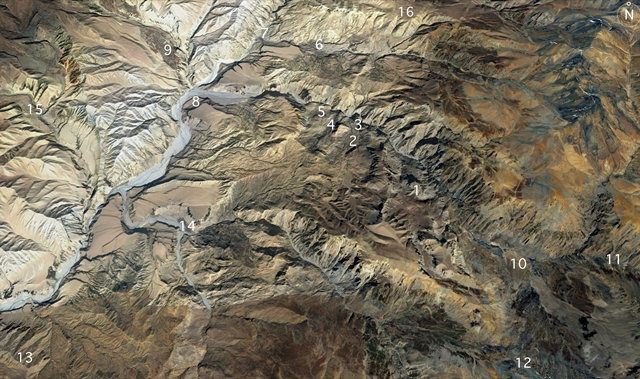
Fig. 1. Screenshot of Shar-ri region (Google Earth July 11, 2017). Modified by Fidel Devkota.
1) Kya Valley rock art site, 2) present settlement of Dhe, 3) Zhong-phug (Ludak) rock art site 4) Nagposa land slide, 5) Rong area, 6) Yara Village, 7) Di Village, 8) Thangchung/Tsamwale (future resettlement site of Dhe Village),* 9) Tsarang Village, 10) Gha-yul settlement (ruin), 11) Byang plain (eastwards), 12) Kog area (southwards), 13) Shöyul (southwest), 14) Tangya Village, 15) Ghemi Village, and 16) towards Chödzong Gompa and Samdzong settlement.
Due to the negative consequences of climate and environmental changes in the region, Dhe village is about to be resettled in the plain of Thangchung (Thang-chung, 3300 m). As a part of the resettlement project, more than 10,000 apple and other fruit trees have been planted. This resettlement site (3200 m) and orchard area are commonly referred to as Thangchung-Tsamwale (v. Devkota 2016).
Most of the rock art discussed in this paper is from a site on the edge of Kya (Skya) Valley (4000 m) inside Dhe Village territory (fig. 1). The rock art site in Kya Valley contains both red ochre pictographs and inscriptions, representing different historical periods (figs. 5, 6). There is also a second site near the cave settlement of Zhong-phug (Rdzong-phug or Grong-phug?, 3700 m) on the lower part of the Ludak (Klu-dag, Limpid Water Spirits) formation (figs. 3, 7). Zhong-phug is a cave settlement believed to have been used by the ancestors of Dhe when they moved from a settlement called Gha-yul (Gangs-yul). The Ludak site consists of red ochre pictographs, which include two human-looking figures, a sun, and a circle with a dot in the middle.
Archaeological background to the rock art sites
Kya is a relatively warm valley used for winter pasture by villagers. It doesn’t have a water source so herders must fetch water from the Dhe River that flows beneath the valley. However, Kya is very important to the villagers of Dhe as it links the present settlement to their previous settlement area of Gha-yul, their prime grazing land in summer and winter months alike (fig. 4).* The pictographs and inscriptions are situated in an obscure part of the valley and few villagers have seen the rock art panel. The site is in a crag facing southeast towards Bhrikuti Himal (6361 m). There are huge rocks scattered around the base of the cliff leading to the site but it is easily accessible. Most of the paintings seem to have been found in a cave or overhang which appears to have been exposed due to a rock slide generations ago. Some of the rock paintings on the site look drastically different from each other and it is safe to assume that they were created in different time periods using different materials and styles. The presence of man-made dwellings with signs of fireplaces and smoke residue also indicate different periods of settlement. The later dwellers most probably were hermits seeking isolation, whose patrons (sbyin-bdag) must have been the ancestors of the Dhe villagers (or from other settlements of the Shar-ri region).
Dhe Village is locally known simply as Dewa or Deba (Bde-ba). Its name is derived from the concept of Sukhavatī (Skt.) or the blissful land of Buddha (Bde-ba-can)
The earliest inhabitants on the Tibetan Plateau are still a mystery, but there is evidence of human habitation during the Stone Age at various sites in Tibet (Chayet 1994; Aldenderfer and Zhang 2004).* It is generally assumed that by the late Neolithic settlers on the Tibetan Plateau were mostly mobile cattle breeders, who advanced westward and southwards through the Himalayas and into the central and northern areas of modern-day Nepal (v. Mishra 1994; Samuel 2004). Upon finding fertile areas and grazing lands for their animals, early settlers adopted agriculture (v. Snellgrove and Richardson 2003). The need for agricultural land, grazing grounds, and the security of the group may have led a group(s) of mobile pastoralists of the southern Byang-thang to migrate to the Shar-ri region (v. Vitali 1997; Vitali 2003). Upon finding their economic needs met, a community may have settled permanently in the region. Thus, the oldest rock art of Kya Valley may possibly be linked to nomadic groups that entered the region with their cattle. Some pictographs contain images of wild yaks and hunting scenes, which may represent a time when nomadic communities were actively involved in hunting for their subsistence (see fig. 11).
The Nepal-German project on high mountain archaeology and excavations in Mustang links the culture in the region to the Megalithic and Prehistoric (Tiwari), Prehistoric and Iron Age Culture (Simons), Megalithic and Neolithic (Schuh), etc. See Ancient Nepal (Journal of The Department of Archaeology, Nepal), no. 136 (1994), nos. 188–189 (2015); cf. Ancient Nepal, nos. 130–140.
http://www.digitalhimalaya.com/collections/journals/ancientnepal/
The study of pictographs and inscriptions inside Dhe territory is incomplete without referring to archaeological findings in Samzdong Village (4200 m) located further north (v. Athans 2014; Gleba et al. 2016). Samzdong is known for shaft tombs, a mortuary tradition dated ca. 400–650 CE (Aldenderfer and Eng 2016). A large wooden coffin with a painting of a horseman, large copper vessels and ladle, iron daggers, wooden and bamboo cups and trays, copper and bronze bangles, glass beads, gold and silver mask, and fabric remains were recovered during various excavation projects in Samdzong (v. Aldenderfer 2013; Aldenderfer and Eng 2016). Such mortuary findings have not been reported near rock art sites or elsewhere inside Dhe territory. Also, there are no legends or myths related to the existence of tombs and burial grounds in Dhe. However, there are extensive ruins of an irrigation system near Samdzong resembling those in Gha-yul and Kog to the south (fig. 8), and there is a topographical similarity between deserted settlements in the Samzdong region and Gha-yul and Kog. There is also a settlement between Samzdong and the Shar-ri region, now in ruins, called Chödzong, which was culturally close to Samdzong and Shar-ri (Sharma and Gurung 1989), but is now part of Lo Manthang Village territory. Furthermore, some rock art in Dhe has a close resemblance to rock art commonly found inside what is traditionally thought to have been Zhang-zhung territory (v. Bellezza 1997; Francke 1995).*
Also see http://www.tibetarchaeology.com (October 2015, November 2015, October 2016, and June 2017 Flight of the Khyung issues).
Settlement history of the villages
There are limited historical records available in the public domain concerning the Shar-ri region that shed light on the social and political development of the region linked to the rock art of Dhe. However, there are oral histories, folklore, and religious accounts that may have a connection to later rock art. The various settlements of Dhe and their relationship with neighboring villages may also furnish vital clues related to the rock art of the Dhe territory.
Later pictographs and inscriptions exhibit Buddhist influences, thus is safe to assume they postdate the 7th century CE and more specifically, probably coincide with the second diffusion of Buddhism in Tibet (post-10th century CE). Sources mention that in the late 10th century CE Lo was part of Bkra-shis-shis-mgon’s dominion in Western Tibet, also known as Mnga’-ris skor-gsum (Kramer 2008; v. Vitali 2012).* There were numerous religious movements in and around the Shar-ri region after 1000 CE, which may have some connection to the pictographs and inscriptions in Kya Valley and Ludak. Population movements in the area may have already begun following the assassination of Glang dar-ma, the last king of Tibet, circa 842 CE (v. Dhungel 2002; Kind 2012). Many famous Buddhist masters including Mi-la ras-pa appear to have visited Lo Mustang in the 11th century CE (Kind 2012).
Mnga’-ris skor-gsum was ruled by the three sons of Nyi-ma mgon, viz., Dpal gyi mgon, Bkra-shis mgon, and Lde gtsug-mgon. Also see Tucci 1956; Francke 1926; Jackson 1976.
From the 10th to the 13th centuries CE, Lo Mustang saw a Buddhist renaissance and the rise of the Yungdrung Bon tradition (ibid). The rock art in Dhe should have some association with the resurgence of Buddhism in the region during that period. Dharnal (2008) has published cave paintings and rock engravings from the Glo-stod and Glo-smad regions highlighting the influence of Yungdrung Bon and Buddhism, especially ca. the 13th–14th centuries CE but also later. His published work includes plates of wall paintings from various monasteries in Lo Manthang, Mardzong, Klu-ri, and Tangya, to name a few. Rock engravings of Samar Village and Kak Nyingba (in Glo-smad) and the Tsarang cave have symbols of anthropomorphic figures, blue sheep, hoofprints, serpents and sun disks, which bear some resemblance to rock art found in Dhe. The pictures presented in Dharnal’s article are all in black and white and the images are not clearly visible (ibid., pp. 22, 29, 30 [plate no. 30, 40, 41, and 42]). A careful survey of the sites and analysis are needed to date the engravings and highlight the connections to rock art found in Dhe territory.
Dhe villagers believe that their ancestors moved from Gha-yul (4500 m) to Zhong-phug (3700 m) before settling in Dhe (3900 m). Ruins of a settlement, irrigation system (yu-ra), and fields are clearly visible in Gha-yul. The ruins include poorly preserved rudimentary impoundments made of stone (rdzing-khang), which are very hard to date on typological grounds alone, especially as not much of significance is visible in the ruins. However, among the ruins in the Khang area is a separate and bigger structure called Smad lha-khang (Chapel of the Lower Region). There is also a roseate-like stone in the ceremonial ground close to the settlement and fields; villagers believe it to be the place where cremation rites were held in the past. There are numerous other sacred sites (gnas) and mythical places in the Gha-yul Valley, which highlight close connections between the Yundgrung Bon and Buddhist religions (v. Devkota 2016).
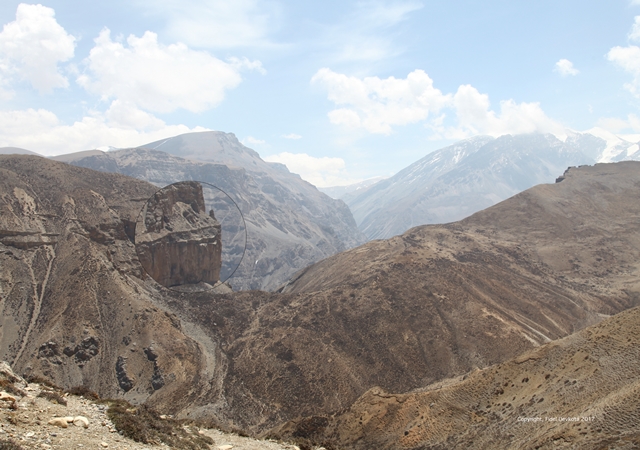
Fig. 2. Rock art site in Kya Valley (circled), Dhe territory, Lo Mustang. Photo: Fidel Devkota.
There was another settlement of similar altitude east of Gha-yul, near the Manang District border called Kog. Kog is thought to have been founded ca. the 10th or 11th century CE (Ramble 2007). It is believed that the present settlers of Tangya Village are the descendants of Kog. Residents of Shar-ri think that Kog and Gha-yul were closely connected contemporaneous settlements, which is mirrored in the intimate socio-cultural relationship between Dhe and Tangya. According to a ‘Chronicle’ (Ramble 2007: 58), the people of Kog migrated to Te, Tshug, and Nar, in the northern part of Manang district (ibid.). There are also some clans such as Dokpa Niwa (Ghapa Nyingpa?) from Kog that migrated to Dhe and other parts of the Shar-ri region. The Te and Tshug settlements are part of the Seke (Se-skad) speaking Shöyul settlement (Shod-yul), which means village(s) in the lower area (v. Ramble and Seeber 1995).* It is interesting to note that Gha-yul is derived from a combination of the Tibetan terms gangs-ri (mountain) and yul (village), which roughly translates as ‘mountain village’. Perhaps the ancestors of Gha-yul and Shöyul were responsible for some of the rock art in Dhe territory. It is also possible that rock art of the later phase is present in other places in Shar-ri and Shöyul. Upon seeing photos and video images of rock art from Dhe, villagers from Tangya informed me about the existence of ‘rock art’ in their territory but this has not been verified.
Ramble and Seeber (1995) point out five major settlements: Taya, Tshug (Tsuksang), Tsele, Gya-ga (Gyagar) and Dzong. Some part of Shöyul lies in Se-rib (Glo-smad) which is also known as Baragaun in Nepali (cf. Jackson 1976; 1978).
The creators of rock art in Dhe territory may have been related to Tangya or even to other villages as far south as Shöyul and Nar-phug in Manang District (cf. Ramble 2007; Devkota 2016). Hermits may also have been responsible for some of the rock art in Kya Valley, whose patrons were from Dhe and Tangya (possibly other villages in the vicinity as well). A Lama Gur-gsom established a Yungdrung Bon monastic community at Gdong-kya circa the 10th century CE (Vitali 2012), a settlement that later became known as Tangya. It seems that Gdong-kya and Kya have some connection because of cognate elements in their names.
Some of the rock art in Kya Valley may be related to the spread of Yungdrung Bon in the late 11th century CE. The practitioners of the Oral Transmission of Zhang-zhung occupied two areas of the cave-rich territory in Upper Mustang for Yungdrung Bon meditative practices (Vitali 2012). These were known as the two Bon-skor of Glo-stod. One of them was in the plain immediately north-west of Lo Manthang and the other was east of the Kali Gandaki in Shar-ri (where Tangya and Klu-ri are situated). The precise location of the Bon-skor in Shar-ri is unknown. There is a possibility that the rock art site of Kya was part of this Bon-skor, which is now buried in the rubble caused by the same rock slide that exposed the rock art.
Rong-gsom Rtogs-med zhig-po, a native of Rong in Lo, is said to have meditated in a cave called Glo-stod Rong-phug (Vitali 2012). The Zhang zhung snyan rgyud bla ma’i rnam thar (p. 60 ln. 1) places his cave in the right-hand corner of the upper part of Bon-skor (ibid., p. 31). Rong-gsom Rtogs-med zhig-po must have had a strong connection to his heimat (homeland) ‘Rong’ because it is attached to his name.* Shes-rab rgyal-mtshan, a native of Upper Gtsang, is reported to have come to Stod Mnga’-ris (i.e. Shar-ri region) and meditated in Tangya sometime after 1113 CE (Vitali 2012), upon the instruction of his teacher (Ramble 2004).† Shes-rab rgyal-mtshan is said to have received teachings from Rong-gsom Rtogs-med zhig-po and to have meditated in the cave of Glo-stod Rong-phug (Vitali 2012). Their meeting took place in a village of the Bon-skor located north of the city of Lo Manthang (Ramble 2004).
Rong Village doesn’t exist anymore, but tax documents from 1751 show nine tax paying houses in Rong at that time (Dhungel 2002). These documents list it along with Dhi, Yara, Grong, Dhe, and Tangya. Rong must have been a village of Shar-ri. There is a place beneath Serthang (Gser-thang) and the Pyu hills (Spe’u) inside Dhe territory that is still known as Rong. There are no signs of the ruins of a settlement or fields, but local residents claim that the still active landslide of Nagposa destroyed them generations ago. Herders from Dhe Village still use this area as a pastureland and herders have pens (lhas) there. Some villagers claim that they have seen field-like structures in Rong but this has not been verified.
The younger son of Shes-rab rgyal-mtshan, Klu-brag-pa Bkra-shis rgyal-mtshan (1131–1215 CE) established the famous Bon monastery in Luprak Village (Klu-brag), in Se-rib, Mustang.
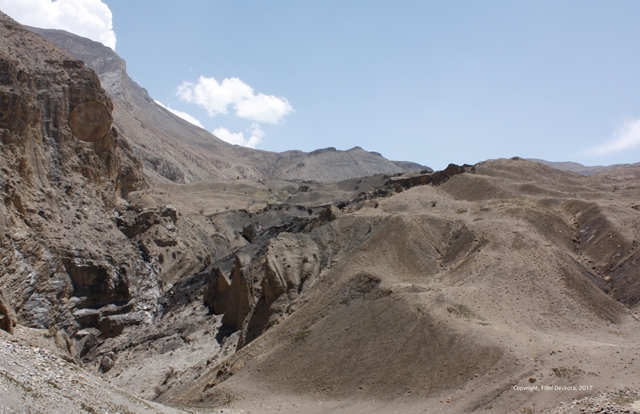
Fig. 3. Rock art site near Zhong-phug (circled). It was unknown to the villagers of Dhe until recently.
The rock art site at Ludak near Zhong-phug contains a limited number of pictographs. Even though the rock art site was exposed, it was not known to local residents until the Spring of 2014. The site lies close to Zhong-phug, where the ancestors of Dhe are said to have lived for generations before they moved to the present settlement. Zhong-phug is also close to an area known as Rong where another settlement is said to have once existed (v. Kramer 2008, Dhungel 2002). Rong and a cave settlement area near Dhe are part of the modern-day territory of Dhe. There is a man-made enclosure a few meters away from the Ludak pictograph site with scattered Tengyur (Bstan-’gyur) and Kangyur (Bka’-gyur) volumes. This enclosure seems to have been created during or after the second diffusion of Buddhism in Tibet, thus it is probably historically related to the rulers of Mnga’-ris skor-gsum and/or the later rulers of Lo. There are also a few religious inscriptions on the walls but they seem relatively new.
Rong may possibly be associated with Rong-phug of the Yungdrung Bon tradition. A hypothesis I had concerning the whereabouts of the missing Bon-skor led to the discovery of the Ludak rock site, which is situated near an abandoned cave settlement of Dhe. The oral tradition suggests that these sites may be related to the hermitage of Shes-rab rgyal-mtshan and the Bon-skor of Shar-ri. There are still legends about Bon masters meditating in ‘unknown’ caves of Dhe-tang (refers to the combined territory of Dhe and Tangya) ‘who can hear but do not respond…with long hair and nails’.
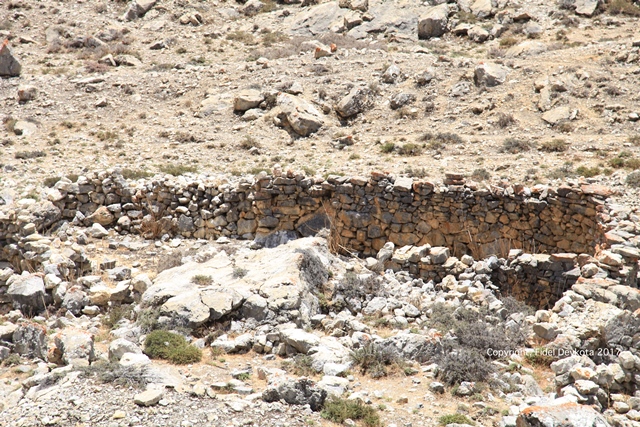
Fig. 4. Ruins of residential structures in Gha-yul. Photo: Fidel Devkota.
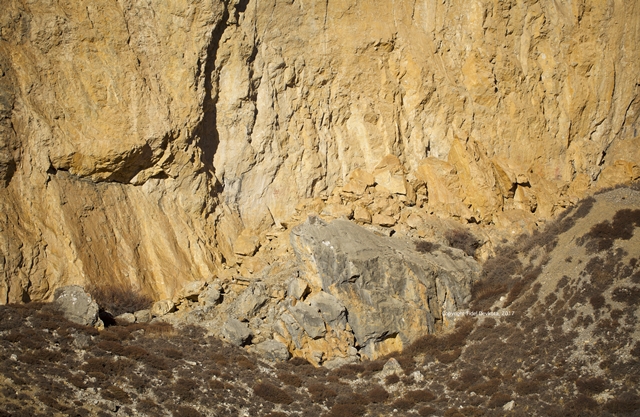
Fig. 5. Main rock art site, Kya Valley. Photo: Fidel Devkota.
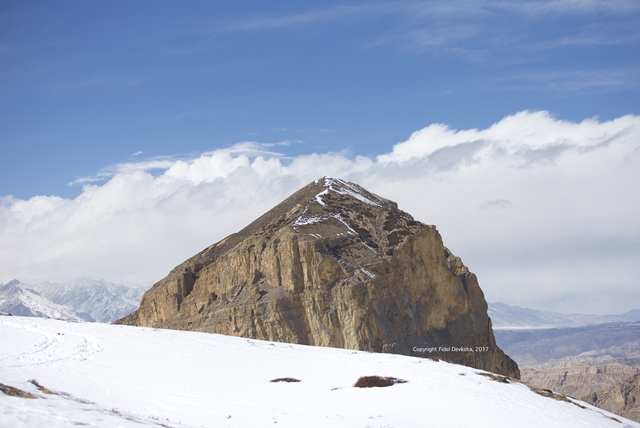
Fig. 6. Crag containing rock art in Kya Valley. Photo: Fidel Devkota.
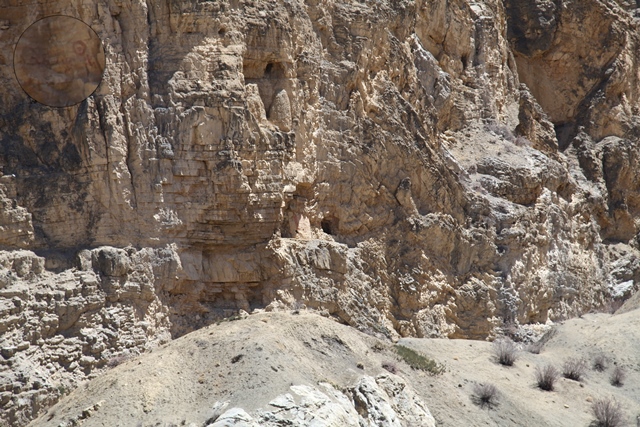
Fig. 7. Crag containing rock art (circled) near Zhong Phug. Photo: Fidel Devkota.
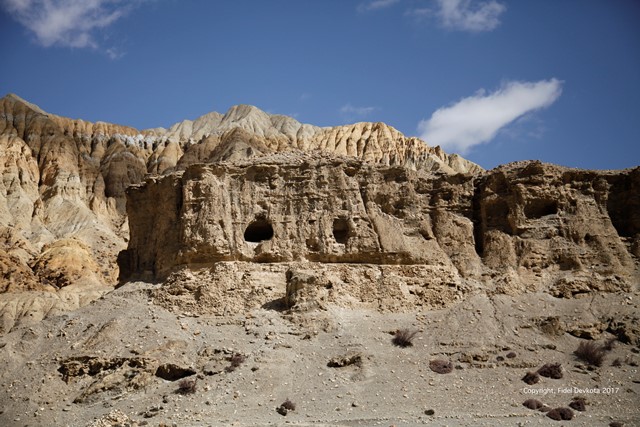
Fig. 8. Ruins of ancient canal system near Samdzong Village. Photo: Fidel Devkota.
Conclusion
The rock art site in the Kya Valley dates to different time periods and has the potential to augment our understanding of the history of Mustang. The first phase of paintings is prehistoric but the later phases are clearly motivated by Buddhism and Yungdrung Bon religious practices. Early rock art in the Kya Valley consists of hunting and religious activities and may be a hallmark of Zhang-zhung or pre-Buddhist civilization in western Tibet. If so, this civilization seems to have penetrated more deeply into the Nepal Himalaya than previously thought. The physical ruins of the Gha-yul settlement may also possibly be linked to Zhang-zhung but it is hard to conclude this from a reconnaissance of the site alone.
The Shar-ri region was frequented by numerous masters from various schools of Tibetan Buddhism such as Ston-pa Yang-rab (a disciple of Atiśa), La-stod Dmar-po (a contemporary of Mar-pa Lo-tsā-ba), as well as the Yungdrung Bon masters Shes-rab rgyal-mtshan and Rong-gsom Rtogs-med zhig-po, to name a few. It can be that the Kya Valley and surrounding area was a refuge visited by one or more prominent masters active during the second diffusion of Buddhism. Closer study of the rock art and locations may lead to the identification of the elusive Bon-skor located in Shar-ri.
Most of the pictographs and inscriptions examined in this article are exposed to the harsh weather conditions of Lo Mustang, which is taking a heavy toll on them. The sites of Kya Valley and Ludak are vulnerable to further rock slides and erosion. Some rock art has deteriorated and pigments have faded. There is also a threat of looting and vandalism once the existence and importance of these sites become more widely known. The wonderful rock art of Kya and Ludak runs the risk of being lost without many people even realizing its importance. An initiative to conserve these precious works is needed urgently if they are to be preserved for future generations. The marvelous heritage of Lo Mustang should not be allowed to fade away into obscurity.
About the author
Fidel Devkota is an environmental anthropologist and a filmmaker based in Berlin and Kathmandu. He holds a PhD in anthropology (FU-Berlin), an MA in visual media anthropology (FU-Berlin) and is a lecturer in the MA program in visual and media anthropology at Freie Universität Berlin. Devkota has almost a decade of research experience in Lo Mustang, especially in the Shar-ri region. His work is mainly focused on the impact of climatic and environmental changes and their implications for local populations in the Himalaya. His broader interests in the Himalayan region include environmental and climate anthropology, visual media anthropology, digital anthropology, applied anthropology, film and media studies, photography, and film production.
Part 2: An appraisal of the rock art and inscriptions of Kya and Ludak
John Vincent Bellezza
Introduction to the rock art and inscriptions
The rock art and inscriptions documented recently by Fidel Devkota in Kya (Skya) and Ludak (Klu-dag), in Lo Mustang (Glo Smos-thang), are a valuable archaeological resource, supplementing other sources of information about the early settlement legacy and cultural makeup of the region.* The red and yellow ochre (oxides of iron) rock art and inscriptions of the two sites are comparable to those documented on other portions of the Western Tibetan Plateau, viz., Upper Tibet, Spiti and Ladakh. The rock art and inscriptions of Kya and Ludak and other sites on the Western Tibetan Plateau (WTP) share numerous parallels in subject matter, techniques of production and geographical settings. Nevertheless, despite these strong affinities, there are clear differences in the styles of rock art in Upper Tibet, Spiti, Ladakh, and Mustang, indicating that this vast plateau area was distinguished by considerable regional complexity.†
My assessment of the rock art and inscriptions of Lo Mustang is based solely on an appraisal of photographs furnished by Dr. Devkota (I have not been able to visit the region yet). Although there are high resolution copies of the images published here, photographic documentation of the rock art and inscriptions carried out represents a preliminary stage of study. Many of the images are not fully in focus and there are very few close-up shots available for examination. Moreover, not all red ochre pigment applications were photographed, therefore, a comprehensive inventory of compositions and epigraphs is still pending. Exercising much diligence in his work, Dr. Devkota has informed me that he plans to return to Lo Mustang to more thoroughly document rock art and inscriptions.
Over 700 rock carvings (petroglyphs) have been discovered at Kak Nyingba, lower Mustang, the first rock art to have been documented in Nepal. See Pohle 2000; 2003 (from which the following review of site contents is derived). For an analysis of certain findings of Pohle 2003, see Flight of the Khyung, July 2015. The rock art of Kak Nyingba has a considerably different cultural alignment and geographical setting than that of Kya and Ludak. Kak Nyingba is dominated by symbolic subjects (squares, semi-circles, solar discs, spirals, etc.), cup-marks, and hoofprints carved on the sandstone banks of the Kali Gandaki river. Early figurative subjects include deer, snakes, axes, and wild yak and blue sheep hunting scenes. Early non-Buddhist figures and/or Lamaist (Buddhist and Yundrung Bon) figures at Kak Nyingba include tiered shrines, swastikas and vases. According to Pohle, the diverse contents of the site and the frequent superimposition of carvings indicate that the location was used from prehistoric times until well into the historic era.
The rock art of Kya and Ludak consists of at least ninety red and yellow ochre pictographs. Most of these pictographs are figurative representations (physical objects and lifeforms), but there are also at least four examples of the sun and a crescent moon among them.* Literal associations notwithstanding, this celestial imagery is liable to have symbolic value (meaning in emblematic or epitomized form). Figurative art is dominated by wild ungulates (wild yaks, wild caprids, cervids, and horses), but there is also one bird and one striped feline (probably a tiger). There are also at least nine anthropomorphic figures represented. Although the total number of pictographs is relatively small, the range of subject matter is quite diverse stylistically. For example, among the nine anthropomorphs in the rock art of Kya and Ludak, there are six different types. Moreover, the artistic proficiency and painting techniques exhibited by the pictographs vary considerably. These diverse qualities are indicative of significant variability in execution, scene composition and chronological placement. A medium red ochre dominates the palette of pigments used at the two sites. Magenta or purplish colored ochres (such as those seen in the pictographs of Gnam-mtsho and Spiti) are encountered at Kya (e.g., fig. 37). The use of yellow ochre is restricted to the highlighting of figures in a single complex composition (fig. 9) and for much more minor applications (e.g., fig. 23).
Interestingly, no swastikas (g.yung-drung) have been recorded at Kya or Ludak. The swastika is the quintessential symbol of Upper Tibetan and Spitian rock art and is also a key symbol in Ladakh. It is likewise encountered (oriented in both directions) in Kak Nyingba, lower Mustang (Pohle 2000; 2003).
Despite careful formulation of the stylistic and technical criteria used to date rock art in this work, my appraisal is based on inferences drawn from a wide variety of data and is subjective in nature.* Corroboration relying on direct means of dating will not be feasible until technical obstacles plaguing chronometric analysis rock art worldwide are ironed out. Based on a comparative study of rock art the WTP, the pictographs at Kya and Ludak can be divided into two broad epochs: prehistoric (pre-7th century CE) and historic (post-7th century CE). More specifically, the rock art of Kya and Ludak is attributable to the Protohistoric period (ca. 100 BCE to 650 CE), Early Historic period (ca. 650–1000 CE) and Vestigial period (ca. 1000–1300) CE.† The Early Historic period is further divided into the Imperial period (ca. 600–850 CE) and post-Imperial period (ca. 850–1000 CE). The chronological scheme proposed here is identical to the one I have used for Upper Tibet and Spiti. Under a slightly different nomenclature, it is also applicable to Ladakh. The significant aesthetic and technical affinities displayed by rock art on the WTP confirm the utility of an allied approach to dating rock art in Lo Mustang.
On the chronology of rock art in Upper Tibet and Ladakh, see Bruneau and Bellezza 2013; on Spiti, see the Flight of the Khyung, July 2015; Bellezza 2017. For the chronology of specific types of rock art in Upper Tibet, see Flight of the Khyung, passim. On the chronology of tiered shrines, also see Bellezza in press-a. Comprehensive surveys of tiered shrines and mchod-rten rock art and rock inscriptions in Upper Tibet will appear in upcoming issues of Flight of the Khyung.
Unlike Upper Tibet, Ladakh and Spiti, none of the rock art discovered in Kya and Ludak appears to predate the Protohistoric period. That is to say, there are no compositions readily attributable to the Late Bronze Age or Iron Age. The ethnohistorical factors accounting for the apparent lack of older rock art in Lo Mustang are unknown. The Late Bronze Age/Iron Age in Mustang is represented by cave burials at Chokhopani (ca. 1200–450 BCE), and the Iron Age/Protohistoric period by the funerary site of Mebrak (ca. 450 BCE to 100 CE) and Samdzong (ca. post-400 CE). For prehistoric Mustang, see references in bibliography. Also see “Enduring Tibetan Legacy: A review of an article concerning the genetic make-up of ancient Mustang” (Flight of the Khyung, May 2017); “The Ancient Burials of Mustang: A review of a recent article by Mark Aldenderfer and Jacqueline T. Eng” (Flight of the Khyung, June 2017); Flight of the Khyung, forthcoming, October 2017.
All inscriptions featured in this work are in the Tibetan language. The comparative epigraphic studies I have carried out in other regions of the WTP indicates that the rock inscriptions of Kya are datable to the Vestigial period. * The paleography of rock inscriptions in Lo Mustang exhibits analogous characteristics and is interrelated to other regions of the WTP. In the Vestigial period, the imagination and efforts of carvers and painters turned towards creating the written word on fixed rock surfaces. Inscriptions were also regularly engraved in relief on portable stones (so-called ma-ṇi stones) after 1000 CE. By the 13th or 14th century CE, the technically more sophisticated carving of inscriptions in relief (on both portable and fixed rock surfaces) eclipsed the shallow-sweep gouging of earlier times. After ca. 1300 CE the use of red ochre to make inscriptions also fell out of favor on the WTP.
This chronological nomenclature derives its name from the fact that after ca. 1000 CE, very little rock art was still being produced on the WTP and what was being made tends to exhibit degraded esthetic and technical qualities.
Rock art compositions at Kya and Ludak include birth giving, hunting and other wild animal-human interactions, solitary anthropomorphic portraiture, tiered shrines, and sacred/cosmic symbols. This range of compositions appears to encompass the mythic, the cosmological, the ritualistic, the magical, and other themes generally subsumed under the catchall term of ‘religion’ or ‘cult’. From the subject matter present, it can be concluded that the rock art theatres of Kya and Ludak were not intended for the recording of mundane domestic or economic activities.* These areas of life are totally lacking in the representations. The restricted purview of subjects and scenes gives no insight into whether the makers were pastoralists or agriculturalists, or both (as is still prevalent on the WTP).† Rather, during the entire period of production, the rock art of Kya and Ludak focused on the more cherished beliefs, values and activities of the makers: the extraordinary (heavenly bodies), the socially enhancing (hunting), the ceremonial/ritualistic (tiered shrines), and the vital (birthing).
Depictions of domestic life, shelters, herding, farming, and other ordinary activities finds little graphic expression anywhere on the WTP. This is also true of the contents of many other rock sites in Inner Asia.
Likewise, at the Kak Nyingba rock art site, in lower Mustang, there are no overt signs of agriculture or herding. See Pohle 2003, p. 6.
While we can infer that various religious ideas and activities in a broad sense were carried out through or articulated in the set of subjects and scenes at Kya and Ludak, pinpointing specific traditions and ideologies is very difficult, if not impossible. An introductory article is not the place to dwell on the complex theoretical issues involved in the interpretation of rock art. I will therefore limit myself to a few brief observations.* A methodologically rigorous study of local ethnographic patterns, Tibetan literary records, collateral archaeological data, and rock sites from other regions of the world can provide insight into the religious traditions and ideologies embodied in the rock art of Kya and Ludak; however, this approach does not incontrovertibly establish the meaning and function of figures and symbols, individually or in aggregate. This is particularly so for rock art made before the advent of written records. Even after literacy spread widely in Lo Mustang in the 10th and 11th centuries CE, interrelationships postulated between contemporaneous rock art and textual sources remain somewhat speculative. Unable to corroborate the precise purposes and uses of most rock art, we are left with general observations and impressions suitable for formulating hypotheses concerning its cultural, social, political, and economic significance.
On questions related to the use and efficacy of ethnographic, textual and archaeological sources of information for interpreting the meaning and function of rock art on the WTP, see Bruneau and Bellezza 2013; Bellezza 2008, pp. 171–175; 2014c; Flight of the Khyung, July 2015, May and July 2016, April 2017. For the use of Tibetan textual sources in the interpretation of archaeological materials, see Flight of the Khyung, June 2017.
As can be seen in figs, 2 and 3, supra, the rock art of Kya and Ludak are located in remote and towering locations. These sites are situated away from major routes of communications and hidden from view except when in close proximity. That the two sites are removed from villages and lands for economic subsistence suggest that they enjoyed an exclusive or specialized status. This sequestered aspect possesses the geographic qualities of a kind of sanctuary, which was probably used by a restricted segment of ancient society for exclusory purposes. The range of subject matter in the rock art also bears this out. As noted in Part 1, the rock art site of Kya may possibly be related to a Bon-skor, one of the Yungdrung Bon religious centers in Glo. The reuse of prehistoric cult sites after the 10th century CE for the exercise of Lamaist religions is not uncommon on the WTP.* The locations of the Kya and Ludak sites recall the geographic situation of sites with red ochre pictographs in Spiti. The rock art of these Spitian cult sites is also interrelated esthetically, thematically and chronologically with that of Lo Mustang.†
There are numerous examples in Upper Tibet, such as some of the thirty-seven assembly places (’du-gnas) later associated with Yungdrung Bon, caves attributed to Gu-ru rin-po-che with pre-Buddhist rock art and structural remains, and archaic edifices repurposed as venues for Buddhist meditation. See Bellezza 2014a; 2014b; 2014c. For Ladakh, see Devers 2014.
The cave sanctuaries of Spiti with rock art referred to are Sku-bum, Nyi-ma log-sa phug and Srin-mo kha-gdang. See Bellezza 2017; Flight of the Khyung, November 2015.
Gallery of rock art images
This gallery of rock art and inscriptions presents all examples recorded to date at Kya and Ludak, save for several obscure and minor red ochre applications. Most of the pictographs are in Kya; there is just one panel of pictographs at Ludak. By examining the various photographs, an attempt has been made to present the rock art in terms of relative location but this ordering of the materials is tentative. A more complete and accurate spatial analysis of the distribution of pictographs and inscriptions awaits additional fieldwork and GPS measurement. The dimensions of the various pictographs are unavailable.
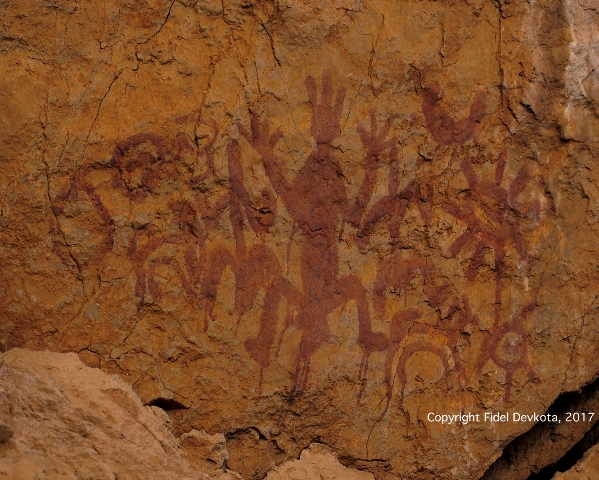
Fig. 9. An integrated red and yellow ochre composition featuring a central squatting figure flanked by two subsidiary squatting figures, all three of which are surrounded on the right by a crescent moon, two sunbursts and what appears to be an animal, and by two interconnected circular subjects and possibly another animal below it on the left side of the photograph. Kya, Lo Mustang. Protohistoric period. Photo: Fidel Devkota.
The central figure, its arms raised and legs spread apart, is squatting in the classic child delivery position. There are three rays, feathers, diadems or some other object on top of the head of the figure. Between its legs is a large irregular motif that appears to depict a living being or egg emerging from the womb. Although less detailed, the two subsidiary figures mimic the aspect of the central anthropomorph. The central figure is shown with four spread fingers on each hand. This composition appears to portray a birth-giving goddess with two hypostases (one may possibly be female and one male, as in dyadic ancestral figures). The subjects bracketing the central and subsidiary figures appear to represent basic constructs of the cosmos, including heavenly bodies and animals.* The upper sun on the right side of the composition was painted with nine rays, nine being a primary cosmological number in old Tibetan traditions.† Squatting birthing figures are known in the rock art of Upper Tibet and Spiti and worldwide more generally.
A mytho-ritual text known as Klu ’bum khra bo, first written down in the 10th or 11th centuries CE, features a myth whose protagonist is a pantheistic goddess named Klu yi rgyal-mo srid-pa gtan la phab-pa (Queen of the Water Spirits Organizer of Existence), she who fashioned the various elements of the universe, including living beings, inanimate objects and cultural foundations, from the various parts of her body. See Bellezza 2008, pp. 342–349. Curiously, the central figure in the Kya composition has a form reminiscent of water spirit (klu) iconography in Lamaist artistic traditions of the historical era. A well-known cosmogonic goddess in Yungdrung Bon is called Chu-lcam rgyal-mo/Chu-lcags rgyal-mo. Although there appear to be functional connections between cosmogonic goddesses of Tibetan literature and the rock art of Kya (and Ludak), it is unclear whether there are demonstrable cultural and historical links between these figures encompassing disparate mediums and time periods. On Tibetan cosmogony, see, for example, ibid.; Bellezza 2005; Karmay 1998; 2003; Haarh 1969; Norbu 1995; Flight of the Khyung, July 2017.
Much has been written on enneads of spirits and objects in the Tibetan cultural world. Here I single out sun symbols with the same number of rays in the rock art of the WTP: Flight of the Khyung, August 2016, figs. 40, 41. Like the lower sun in fig. 9, however, the number of sunrays in rock art varies widely on the WTP. There are also thog-lcags (ancient copper alloy amulets of the sun with nine rays. For one of these and for a specimen with thirteen rays (another important cosmological number in archaic Tibetan traditions), see Bellezza 2004, fig. 21b:
https://www.asianart.com/articles/vestiges/21b.html
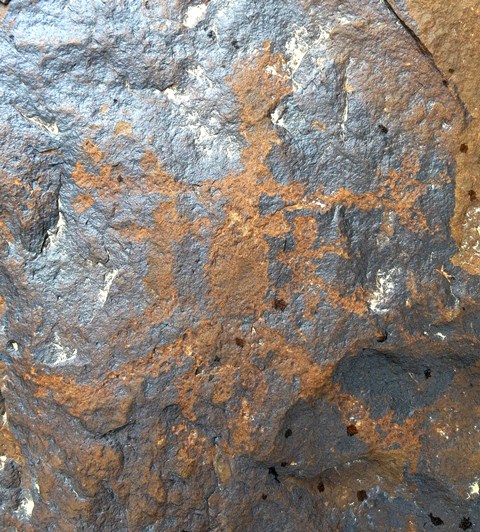
Fig. 9a. A petroglyphic composition consisting of an ostensible central birth-giving goddess with two subsidiary figures. Jo-ba sdod-sa, Spiti. Photo: J. V. Bellezza.
This composition is also dated to the Protohistoric period (see Flight of the Khyung, October 2015, fig. 16.5). This is the only ‘birth-giving’ figure of its type documented in the rock art of Spiti. The two subsidiary figures may possibly be ancestral male and female lineage figures, the progeny of a central cosmic goddess, as might be seen in fig. 9. Rendered in a similar aspect to the Kya specimen, the central anthropomorph from Spiti also has spread fingers. A large object appears between its legs reminiscent of a generative egg, an important cosmogonic motif in Tibetan origins myths. The central figure also appears to be portrayed with a female breast.
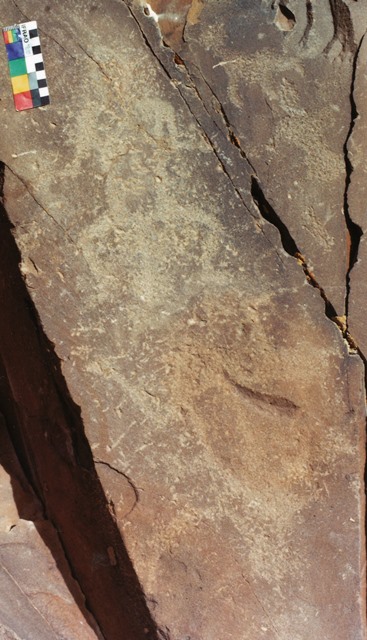
Fig. 9b. Two squatting figures. Ra-’brog ’phrang, Ru-thog. Iron Age. Photo: J. V. Bellezza.
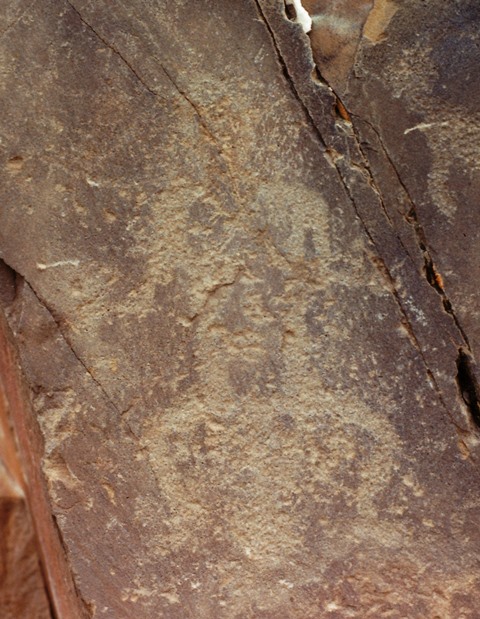
Fig. 9c. A close-up of the upper figure in fig. 9b. Photo: J. V. Bellezza.
This composition appears to depict not one but two birth-giving figures oriented in opposite directions (see Bellezza 2001: 359 [10.81, 10.82]). It has artistic, technical and physical qualities associated with the Iron Age (deeply cut, fine modeling, heavy patina, etc.). The two figures appear to have arms extended outward and the upper one may possibly be shown with breasts. Large objects are situated between their legs, simulating the act of giving birth, or so it seems. In addition to these two figures, there may be another dramatic example of a birth-giving figure in Ru-thog dating to the protohistoric period (see Flight of the Khyung, May 2016, fig. 10). What are commonly referred to as birth-giving figures are more common in the rock art north Inner Asian regions such as the Altai, Sayan and middle Yenisei.* It is possible though that certain simpler squatting figures in the rock art of the WTP are also birthing women (see fig. 16, infra), but the pictorial indications are inconclusive.
On these figures of various kinds, see Jacobson 1997; 2015, pp. 114–151. Many of them are dated by Jacobson to the Bronze Age. For a specimen from Tsagaan Saala IV, Mongolia Altai, sharing motifs in common with the ostensible birth-giving figures of the WTP, see Jacobson 1993, p. 46 (fig. 14); “Animal Mother, Mother of Animals, Guardian of the Road to the Land of the Dead”, OUPblog: https://blog.oup.com/2015/04/animal-mother-ancient-art-mongolia/. Although mascoid (anthropomorphic visages in emblematic form) and chariot rock art on the WTP are almost certainly related to the Bronze Age rock art of north Inner Asia (Bellezza 2008; 2014c; Bruneau and Bellezza 2013), it is not clear whether the same can be said of ‘birth-giving’ figures. There are too few of them known in Upper Tibet and Spiti to make extensive stylistic and thematic comparisons with figures from other regions. At any rate, the apparent greater antiquity of many north Inner Asian variants provides sufficient temporal lead way for their potential spread to the WTP.
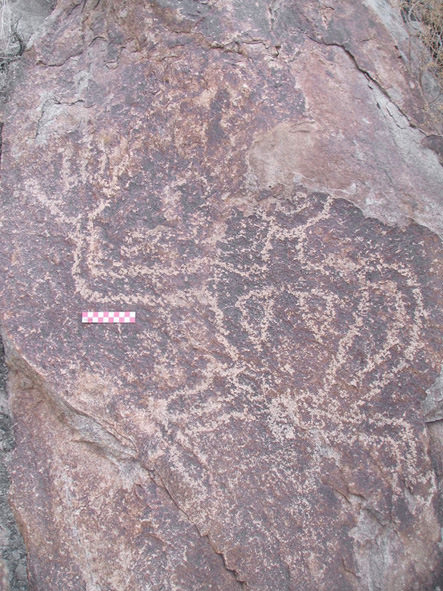
Fig. 9d. What is identified as a birthing figure in the rock art of Nubra, Ladakh. Photograph courtesy of Q. Devers, L. Bruneau and M. Vernier. For photograph, see fig. 8, https://emscat.revues.org/2647.
Devers et al. (2015) interpret this composition from the Kushuwar Thang site in Nubra as a birthing figure, a plausible identification. According to these authors, this type of figure (around 50 cm in height) is unique in Ladakh: she is depicted squatting with triangular breasts, one arm raised and what appears to be a newborn at her side complete with umbilical cord.* Unfortunately, much of the face has been destroyed (only the mouth is still intact). Including the birthing figure at Kushuwar Thang, cognate birthing depictions are found in four major regions of the WTP: Lo Mustang, Upper Tibet, Spiti, and Ladakh. However, the birth-giving figures of the WTP are rare, suggesting a highly specialized function and/or an exceptional cultural status. The figures in the three lower regions (Lo Mustang, Spiti and Ladakh) are portrayed with hands and spread fingers, although the number of fingers varies (three, four and five). This prominent motif appears to signal a potent gesture, the significance of which is unclear. On stylistic and technical grounds, I assign the carved birthing figure in Ladakh to the Protohistoric period (sometimes referred to as Ladakh’s ‘Early Historic period’), just like specimens in Lo Mustang and Spiti.
On this figure and its pictorial characteristics, see Devers et al. 2015, para. 40 and fig. 8.
The existence of birthing figures in the rock art of Lo Mustang, Spiti, Upper Tibet and Ladakh may suggest that the WTP drew from a wellspring of earlier cultural materials, some of which could be of north Inner Asian origins. In any case, trade, religious exchanges, war, migrations, or a host of other hypothetical factors can be proffered to account for the spread of birthing figures throughout the WTP. The same can be said for other common subjects and scenes in the rock art of the WTP: interactions between its constituent parts acted as a catalyst for their widespread adoption. As regards the variable representation of birthing figures on the WTP, somewhat differing lines of religious and cultural development in its respective geo-cultural parts are likely to be indicated.
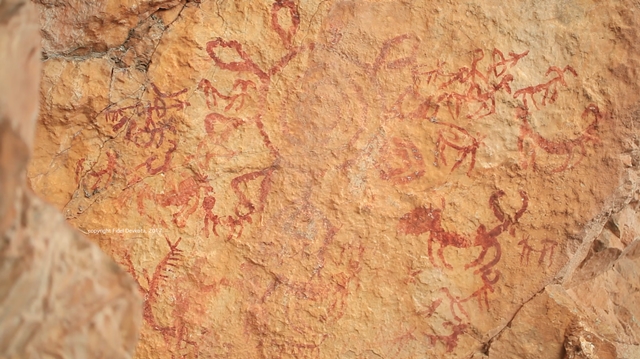
Fig. 10. A panel of rock paintings at Kya, Lo Mustang. Protohistoric period. Photo: Fidel Devkota.
In the middle of the panel there is a large solar orb with diamond-shaped rays that appear to be nine in number.* It is not clear how many of the surrounding figures were made by the same artist, if any at all. On the upper right side of the panel, an archer mounted on a horse is pursuing a wild caprid (resembles a blue sheep). Below these two figures are seven or eight other wild ungulates including at least one or two wild yaks. On the upper left side of the panel, another mounted archer is attacking a wild caprid. Below the hunting scene are perhaps five more wild ungulates, wild yaks among them. Throughout the WTP it is very common to find hunting compositions featuring bowman attacking wild caprids, cervids and wild yaks, which are set among other animals of the same or different species. Aside from the economic and social functions of hunting, these composite scenes appear to encapsulate mythic, ritualistic or cosmological themes around which the fecundity of wild animals played an important role. Lower on the panel are the remains of two tiered shrines, one of which seems to have a forked top. Similar representations of tiered shrines are found in the rock art of most areas of the WTP and in northern Pakistan, although there are regional distinctions in their styles and designs. Accordingly, the two pictured here vary slightly from those of other regions. For more details of this panel, see figs. 11, 12.
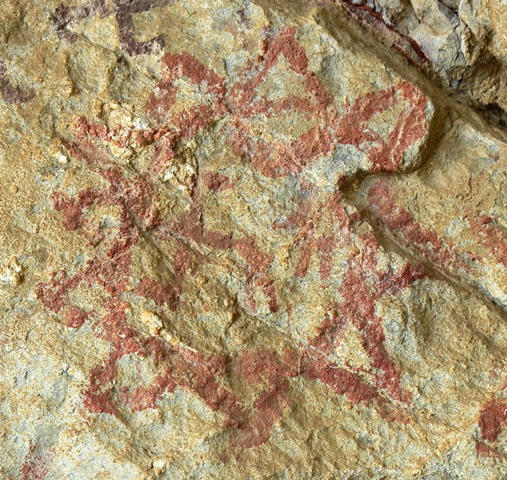
Fig. 10a. A red ochre pictographic sun of nine rays found in a remote cave once used for cult purposes, Srin-mo kha-gdang, Spiti. Photo: J. V. Bellezza.
This pictograph is assigned to the Protohistoric period (see Flight of the Khyung, November 2016, fig. 28.11). The sun symbols of Spiti and Lo Mustang have decorative elements inside the central disc (including one or more concentric rings). In both peripheral plateau regions of the WTP, these large sun symbols with nine rays occupy a prominent position among a panel of pictographs. The Spitian example is also set among diverse figures, although this group of pictographs differs significantly in form from the group in Lo Mustang.
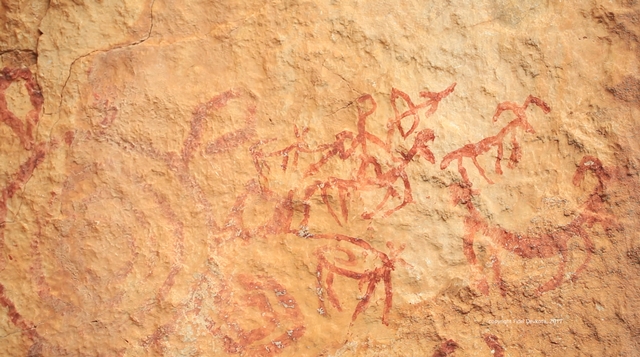
Fig. 11. Close-up of figures on the upper right side of the panel depicted in fig. 10. Photo: Fidel Devkota.
Note how the mounted archer appears to be leading a canine.* Hunting dogs are quite common in the rock art of Upper Tibet and Ladakh.† All over the WTP the bow and arrow is the hunting weapon of choice. The exaggerated size of the arrow seen in the Kya composition is a common artistic device on the WTP (it may have functioned to accentuate its killing power). Chasing animals on horseback might not have been practical near Kya, but this is where painters and later inscribers chose to flaunt their handwork, sequestered from the ordinary course of activities in villages, pastures and hunting grounds.
There is a carved composition consisting of a mounted archer with a dog hunting a blue sheep at Kak Nyingba, in lower Mustang. See Pohle 2003, pp. 5, 6.
In Spiti, however, there are very few hunting scenes with hunters on horseback and even fewer representations of dogs coursing game. The predominant form of hunting in Spiti revolved around caprids, and must have been mostly carried out in rugged terrain not conducive to the use of horses and hounds. See Flight of the Khyung, September 2015, fig. 8.1.
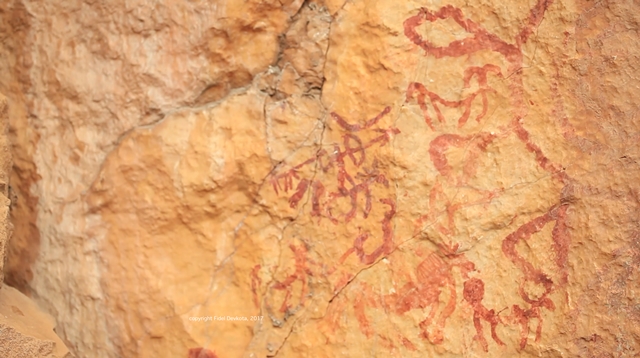
Fig. 12. Close-up of figures on the upper left side of the panel depicted in fig. 10. Photo: Fidel Devkota.
The archer depicted on this side of the panel appears to be standing on the back of his horse (there is no convincing evidence yet that women are depicted in hunting scenes of the WTP). This acrobatic display of riding and hunting skills is occasionally seen in the rock art of Upper Tibet.* Note how one of the horns of a wild yak on the bottom right side of the image overlaps with one ray of the large central sun of the panel.
Horse riding figures in Upper Tibetan rock art will feature in an upcoming issue of Flight of the Khyung.
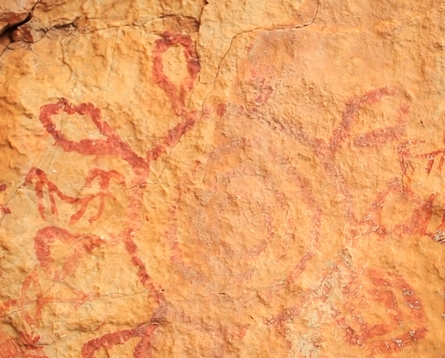
Fig. 13. Close-up of the solar disc in fig. 10. Photo: Fidel Devkota.
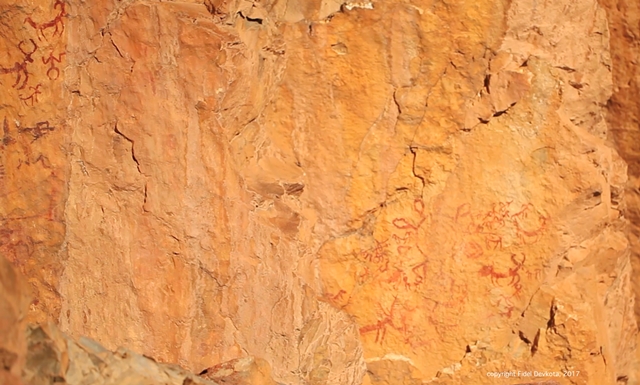
Fig. 14. The panel of rock paintings seen in figs. 10–13 (lower right side) and another panel of figures (upper left side). Kya, Lo Mustang. Protohistoric period. For details, see figs. 14 and 15. Photo: Fidel Devkota.
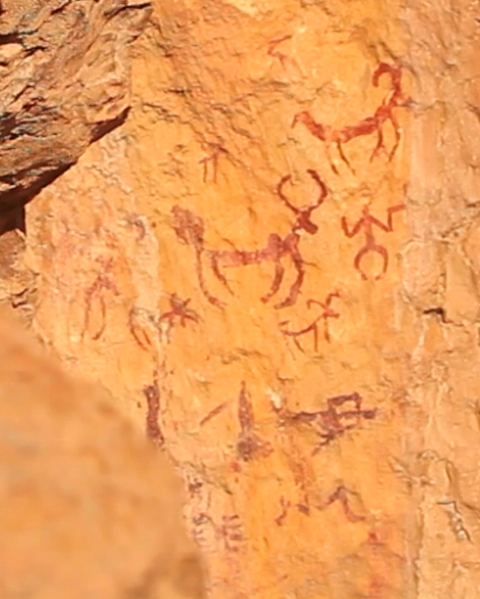
Fig. 15. This panel of pictographs includes a wild caprid (upper right), wild yak (upper middle), anthropomorph (middle right), and other animals and what may be different kinds of subjects below. Photo: Fidel Devkota.
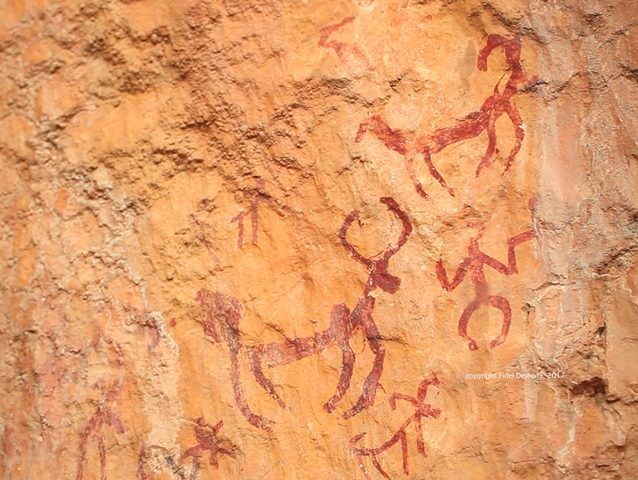
Fig. 16. A close-up of the upper portion of the panel in figs. 14 and 15. Photo: Fidel Devkota.
These various pictographs may possibly form an integrated composition. The anthropomorphic figure appears to be communing or otherwise related to the surrounding wild ungulates. The style of painting has affinities with pictographic and petroglyphic depiction elsewhere on the WTP. The anthropomorphic figure resembles specimens in Ladakh and especially in Spiti, but the precise mix of motifs and the stylistic presentation varies somewhat between regions.* Some of the differences in appearance can be attributed to the individual skills and conceptions of artists, but others appear to be indicative of what might be called a Lo Mustang genre or typology of rock art in the Protohistoric period.
A comparable anthropomorph is found in Kak Nyingba, in lower Mustang. See Pohle 2003, p. 10 (fig. 2, second row in the left column).
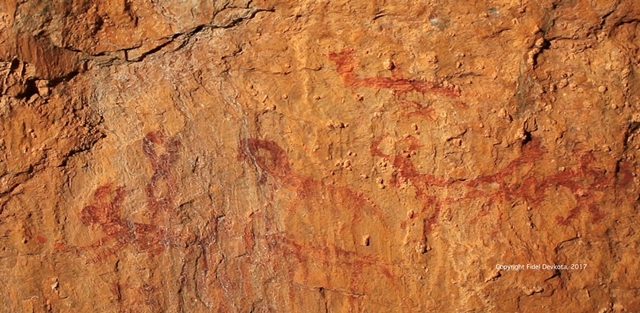
Fig. 17. Another panel of pictographs, including what appears to be a hunting scene, Kya, Lo Mustang. Protohistoric period. Photo: Fidel Devkota.
On the right side of the photograph an anthropomorphic figure with what may be a bow and arrow is in close pursuit of a wild yak. There is what seems to be another animal depicted above the wild yak. In the middle and on the left side of the photograph are three more animals (wild ungulates and possibly another kind of animal). On the upper left is a figure-of-eight subject of unknown function. Figures-of-eight occur in the rock art of other regions of the WTP.
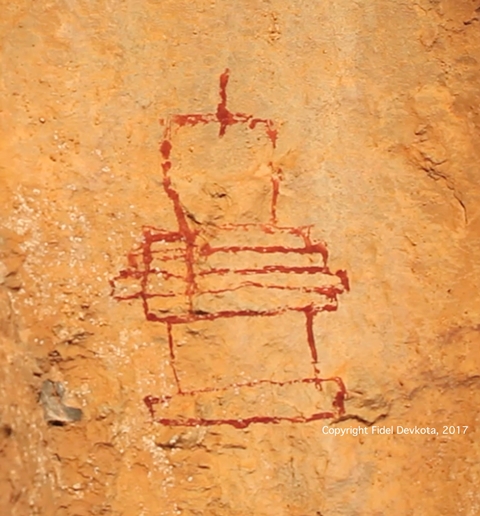
Fig. 18. A mchod-rten with a single short line depicting the spire (’khor-lo). Kya, Lo Mustang. Probably Vestigial period. Photo: Fidel Devkota.
This mchod-rten as well as the one in fig. 19 appear to herald the coming of Lamaist religions to Lo Mustang, a momentous event that can be dated to the late 10th century CE (see Part 1 for more information). There is a chance that it was painted somewhat earlier in the post-Imperial period, but not enough is known about the stylistic development of this type of rudimentary religious monument on the WTP to be more confidently date it. Similar style mchod-rten are also represented in the rock art of Upper Tibet (see Bellezza forthcoming-a, Group 17).
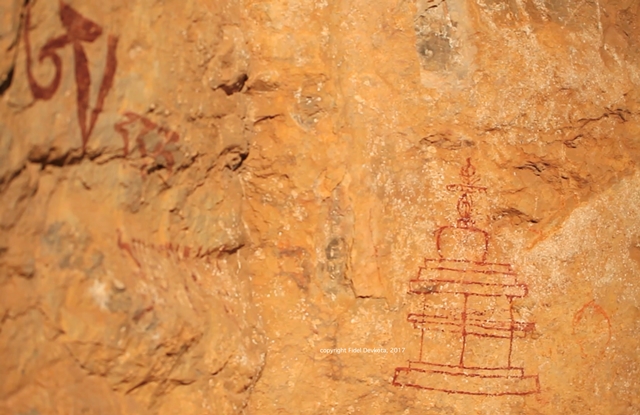
Fig. 19. A mchod-rten (lower right), conch (lower right corner) and the Tibetan letter A (upper left corner). Kya, Lo Mustang. The rock art and inscription are dated to the Vestigial period. Photo: Fidel Devkota.
The mchod-rten, conch and inscription were all made by different hands. This more elaborate mchod-rten has a conjoined sun and moon (nyi-zla) finial associated with Buddhist variants of the religious monument. Nonetheless, the very short spire and tall base are old-fashioned stylizations of architectural qualities not often seen in more modern constructions and artistic renditions. The pigment application to the right of the letter A has not been positively identified (it may be other Tibetan letters).
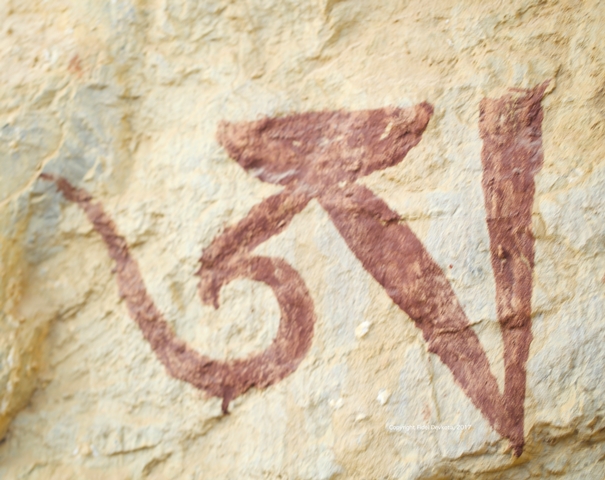
Fig. 20. Close-up of letter A seen in fig. 18. Photo: Fidel Devkota.
The letter A alone functions as a seed syllable, a mantric ejaculation used by Buddhists. Red ochre examples written on rock surfaces belonging to the Yungdrung Bon tradition usually have a subscribed a-chen. There are only one or two short inscriptions among those presented in this work that may potentially have been written by Yungdrung Bonpo. On the other hand, there is a rich corpus of Yungdrung Bon and earlier non-Buddhist red ochre inscriptions in the Gnam-mtsho region of Upper Tibet.
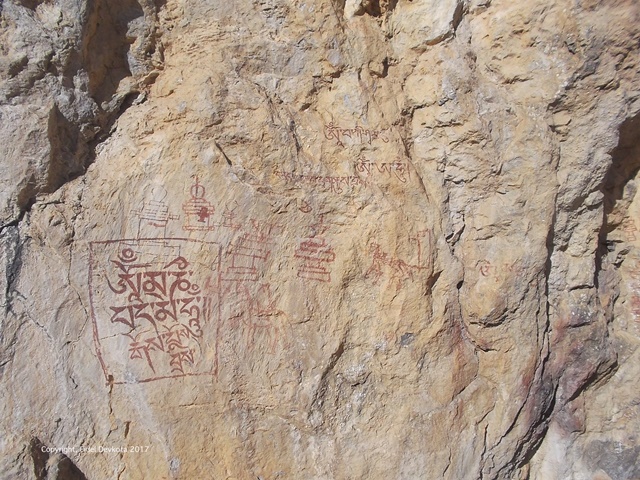
Fig. 21. A rock panel dominated by inscribed Buddhist mantras and dedications as well as mchod-rten. To the right of the framed inscription, a horse and the letter ka are discernable. Another horse is situated to the right of the row of mchod-rten. Kya, Lo Mustang. Photo: Fidel Devkota.
The inscriptions are attributable to the Vestigial period while the mchod-rten appear to be somewhat earlier (possibly post-Imperial period). This is indicated by the way the framed inscription (lower left) was superimposed on one of the mchod-rten. The superimposition suggests that this mchod-rten as well as its four counterparts may have been painted by individuals belonging to a different religious sect, one that came earlier to the site. It is not clear from the design traits of the mchod-rten, however, whether it belonged to a Buddhist or non-Buddhist tradition. For more details, see figs. 22–24.
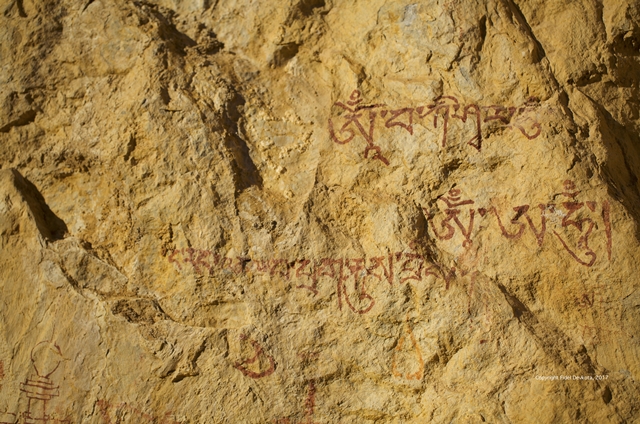
Fig. 22. A close-up of the inscriptions in the upper middle portion of fig. 21. The partially visible mchod-rten (lower left corner) can be also be seen in fig. 21. Photo: Fidel Devkota.
The inscriptions read as follows: Ȭm ba ki shwa ra (= ri) mum (upper), Ȭm A hum (middle), da rang # # pa prag (= brag) rkus (= rkos) bris (lower). The three inscriptions are punctuated by intersyllabic tsheg. The upper inscription is the mantra for the bodhisattva of wisdom, ’Jam-dpal dbyangs. The use of the letter ba instead of the letter wa in this mantra also occurs at Gnam-mtsho in mantras dating to the Vestigial period. The middle mantra consists of the three most common seed syllables. The lower mantra can be translated as: “Today… on this rock formation is written this rock engraving”. This written indication as well as the physical characteristics of the pigment and wear of the three mantras suggest that they were composed at the same time. The initial syllable of the upper and middle inscriptions is a paleographic form of Ōm prevalent in the Vestigial period. The large superscribed element of this syllable is the vowel sign na-ro and the two uppermost elements are known as ma-klad skor, which incorporates the letter ma.*
The use of twin elements to inscribe the ma-klad-skor is also found in Buddhist rock inscriptions in Upper Tibet, but was particularly popular in that region for the writing of Yungdrung Bon mantras. This style of paleography is also seen on Tibetan frescos and portable sacred objects of the Vestigial period.
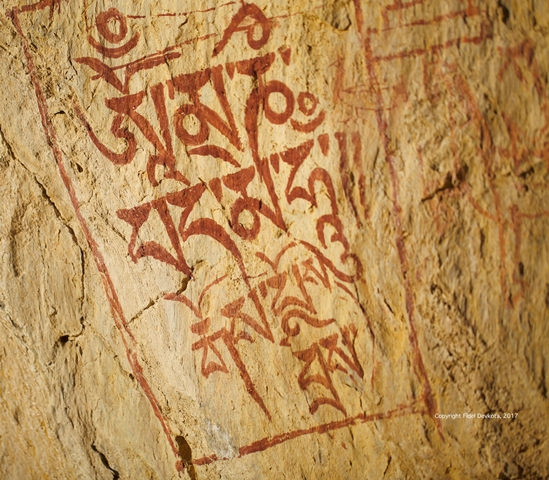
Fig. 23. A close-up of the framed inscription on the left side of fig. 21. Photo: Fidel Devkota.
This inscription reads: Ȭm ma ṇǐ pad me hum rgos (= rkos) pos bris. This inscription states that the ma-ṇi mantra was “written by the rock painter”. In addition to the bipartite ma-klad-skor, this inscription exhibits the reverse i vowel sign (gi-gu log), another old-fashioned paleographic trait.
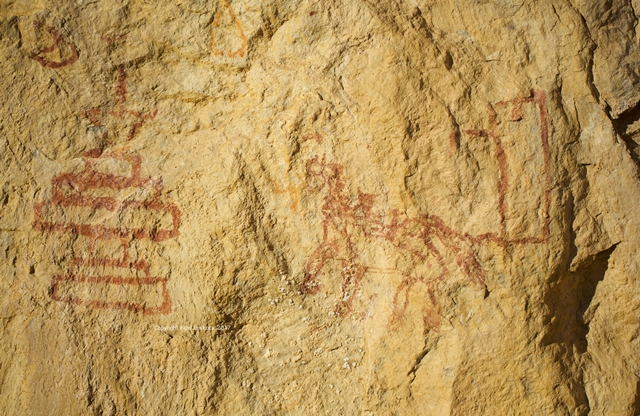
Fig. 24. One of the mchod-rten and the horse seen in the middle of fig. 20. Photo: Fidel Devkota.
The mchod-rten, like others in the same row, was portrayed without much of a spire or finial (tog). The horse has a saddle or something else on its back. The realistic yet relatively stiff depiction of the horse suggests that it was made around the same time as the mchod-rten, coinciding with either the post-Imperial period or Vestigial period.
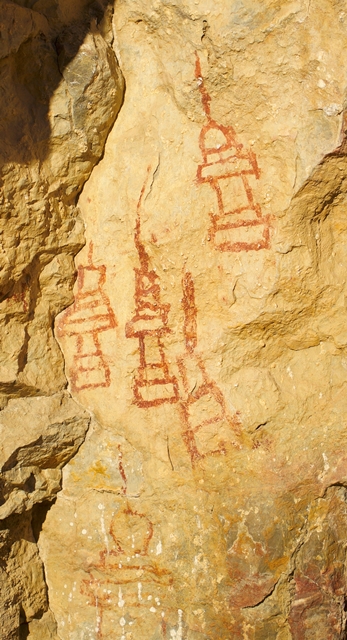
Fig. 25. A rock panel with five mchod-rten. Kya, Lo Mustang. Probably Early Historic period. Photo: Fidel Devkota.
It is not known whether these mchod-rten date to the Imperial period, post-Imperial period or even somewhat later. Be that as it may, these are rudimentary forms of the monument. There are comparable examples throughout the WTP. However, many of those located in Upper Tibet and Ladakh have forked finials, a motif hardly seen at Kya. The religious affiliation of the mchod-rten illustrated here is not certain.
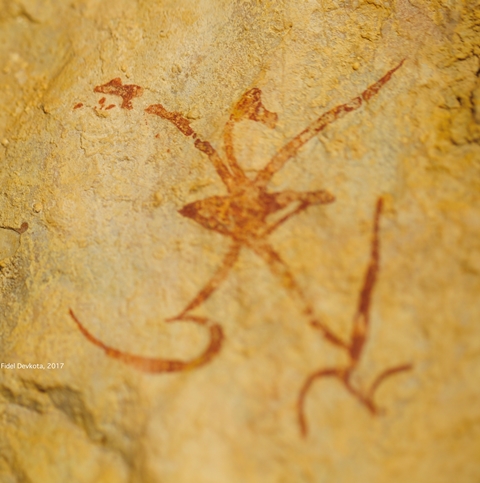
Fig. 26. A mantric syllable. Kya, Lo Mustang. Photo: Fidel Devkota.
This syllable reads: Ȱm. There is a possibility that this inscription may somewhat predate the Vestigial period. We simply do not know. Nevertheless, the curled-stroke ma-klad-skor is a common paleographic feature of rock inscriptions and those written on other media in the Vestigial period. At Gnam-mtsho in Upper Tibet, this type of paleography is associated with both Yungdrung Bon and Buddhist inscriptions. By the end of the Vestigial period, the composite ma-klad-skor had been reduced to a simple dot.
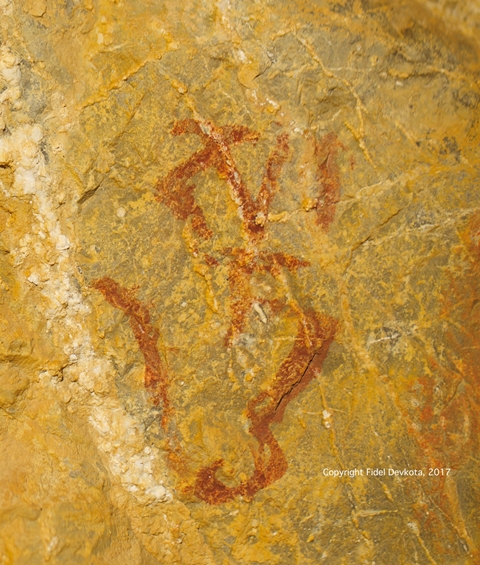
Fig. 27. An inscription. Kya, Lo Mustang. Vestigial period. Photo: Fidel Devkota.
This inscription seems to read stu (vagina), the vertical strokes on either side of the letters forms of punctuation, a kind of yig-mgo (left) and shad (right), but this is not certain. The context in which such an inscription may have been written in unknown. Alternative readings are: sa tu/sa hu. These readings, however, are with little apparent meaning.
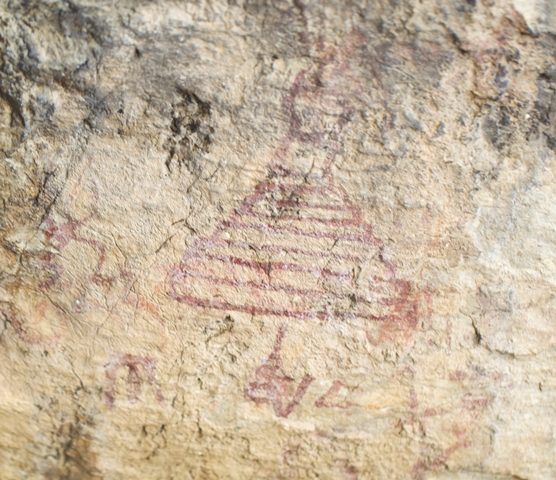
Fig. 28. Multi-tiered mchod-rten with traces of an inscription below. Kya, Lo Mustang. Photo: Fidel Devkota.
The pigment qualities and degree of ablation suggest that the mchod-rten and inscription were made by the same individual. The only letter that can be read is: ma. This may possibly have been part of an incomplete six-syllable ma-ṇi mantra. The mchod-rten and inscription probably date to the Vestigial period, but a somewhat earlier periodization in the post-Imperial period cannot be ruled out.
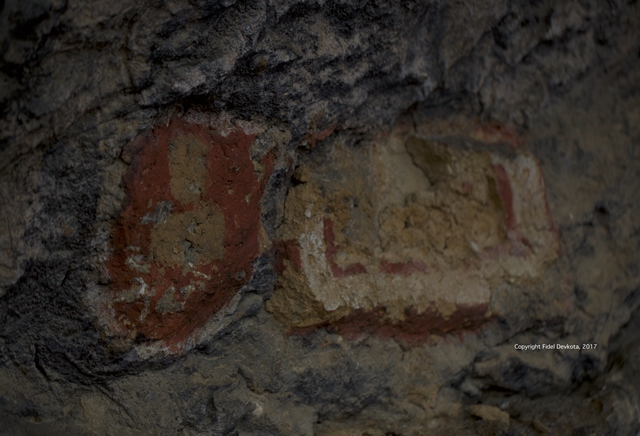
Fig. 29. Two stucco fabrications attached to a rock face. Kya, Lo Mustang. Probably Vestigial period. Photo: Fidel Devkota.
This is not rock art but rather a kind of fresco art, whereby a stucco surface was prepared and colored with white and ochre pigments. It is likely that these surfaces were decorated with divine images or inscriptions but no traces of them remain. If a Bon-skor religious community did indeed exist at Kya, these remains may possibly be evidence of it.
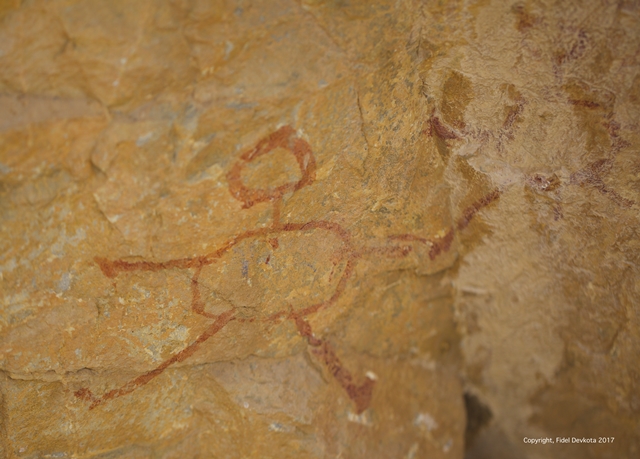
Fig. 30. Two anthropomorphic figures (the specimen on the right is partially cut in the photograph). Kya. Possibly Protohistoric period. Photo: Fidel Devkota.
These outlined figures have round heads and bodies and stick appendages. This style of anthropomorph does not appear to be represented in the rock art of Upper Tibet or Spiti.
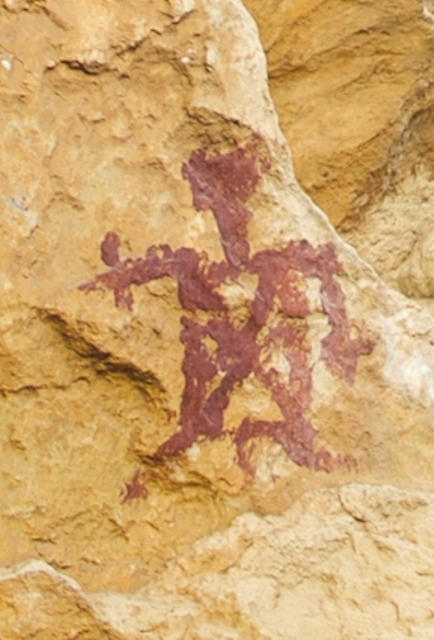
Fig. 31. Solitary anthropomorphic figure. Kya. Probably Protohistoric period. Photo: Fidel Devkota.
The figure X inside a box is known in Upper Tibet and Spiti,* but I am not aware of anthropomorphs ornamented with an X-shaped motif in the rock art of other regions of the WTP.
An X inside a rectangle also occurs in the Kak Nyingba rock art site in lower Mustang. See Pohle 2003, p. 13.
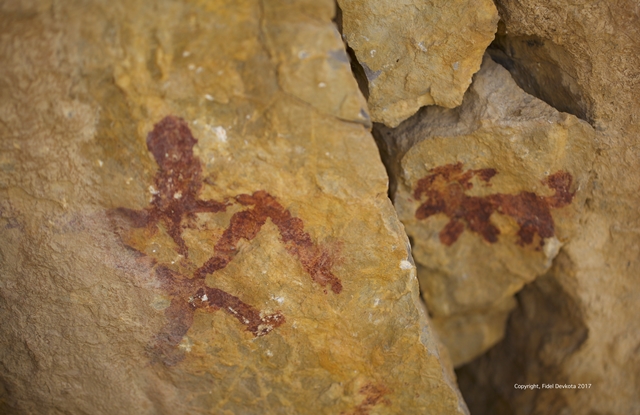
Fig. 32. Anthropomorphic figure and animal. Kya. Probably Protohistoric period. Photo: Fidel Devkota.
This anthropomorph has a triangular body bisected in two equal parts and a thick neck merging imperceptibly with the head. The zoomorph appears to be a depiction of a wild ungulate. The two figures may form an integral composition.
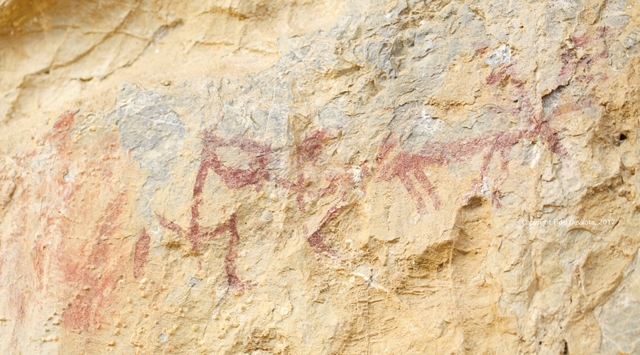
Fig. 33. Wild ungulate and possible hunter. The faint pigment application on the far left is unidentified. Kya. Protohistoric period. Photo: Fidel Devkota.
The animal appears to represent a wild caprid. The ostensible hunter may be shooting a bow and arrow.
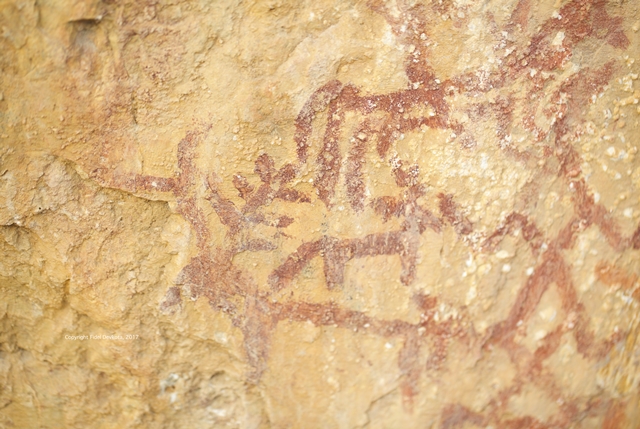
Fig. 34. A stag with branched antlers and other animals. Kya. Protohistoric period. Photo: Fidel Devkota.
Unfortunately, much of this group of pictographs is cut in the photograph. There may possibly be a horseman at the top of the image but only part of it is visible.
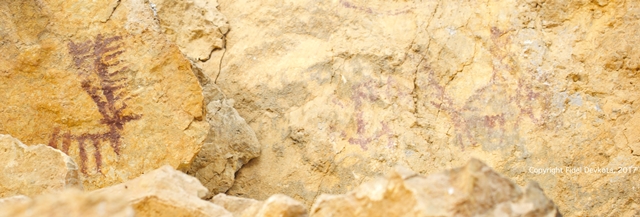
Fig. 35. Stag (left), possible anthropomorph (center) and another animal (right). Kya. Protohistoric period. Photo: Fidel Devkota.
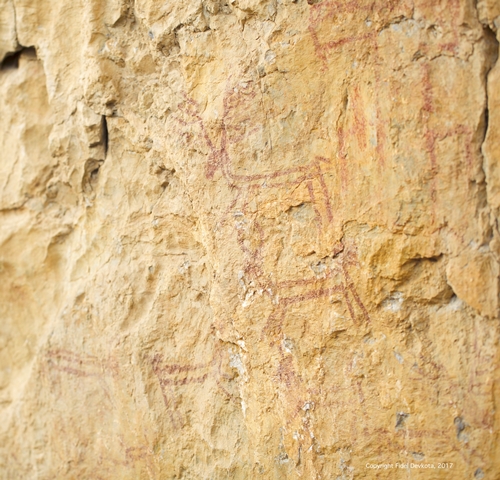
Fig. 36. Stag with branched antlers (top) and four or five other wild ungulates. Kya. Protohistoric period. Photo: Fidel Devkota.
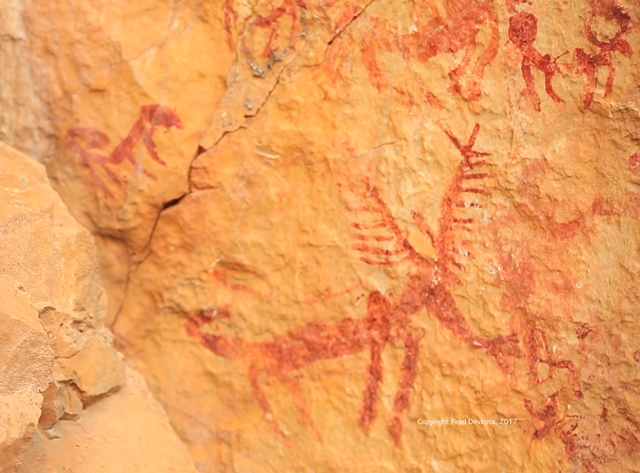
Fig. 37. Stag, wild yak and other animals. Kya. Protohistoric period. Photo: Fidel Devkota.
From what has been recorded so far in Kya, the deer is one of the best-represented animals. The deer also occurs in high frequencies in the rock art of Upper Tibet and to a lesser degree in Ladakh and Spiti. Tibetan textual sources accord the deer a prominent position in the mytho-ritual foundations of Upper and Central Tibet, as can also be observed for the wild yak. The deer was a critical presence in the archaic funerary rites of Old Tibetan literature, but also fulfilled many functions for the living. The Protohistoric rock art of Mustang and Iron Age and Protohistoric rock art of Upper Tibet seem to root these textual traditions in a cultural substrate of great antiquity.
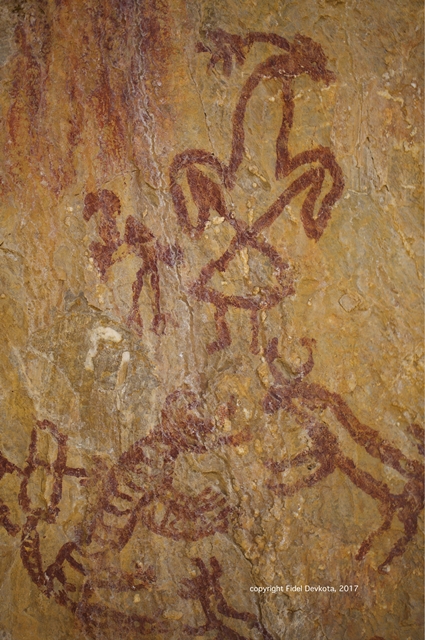
Fig. 38. Bird, tiger, wild yak and other figures. Kya. Protohistoric period or Early Historic period. Photo: Fidel Devkota.
The central trio of animal figures appears to signify cultural and religious themes of great consequence. However, an assessment of the entire composition is not yet possible. The subject to the left of the bird is unidentified. There may be a bowman to the left of the tiger, and the horns of another animal are visible at the bottom of the photograph. There may possibly be other figures nearby. The hunting of wild yaks by tigers was already a theme in Upper Tibetan rock art in the Late Bronze Age and Iron Age.* Nevertheless, the Kya pictograph may not so much portray a literal hunting scene as convey symbolic and mythological information of wide import including that related to predator and prey as a prototypic theme. In any case, the wild yak, tiger and birds are storied animals in Tibet and their depiction in concert can also be traced to early copper alloy objects of the thog-lcags class.† The bird at the top of the composition has certain anthropomorphic qualities. It possesses a long, branched crest on the head and stands on two legs. Ornitho-anthropomorphic figures find a place in the rock art of Upper Tibet and Spiti.‡ However, the Kya specimen with its downward pointing wings is stylistically closer to the raptors depicted in the rock art of Ladakh.§
See Flight of the Khyung, August 2012, January 2014, forthcoming (September and October 2017).
See Flight of the Khyung, December 2010 (fig. 10).
See Bruneau and Bellezza 2013, p. 111 (fig. II.7); Bellezza 2000, pp. 45 (fig. 14), 50 (figs. 26, 27); Flight of the Khyung, August 2014 (fig. 13), August 2015 (fig. 16).
For raptors with downward pointed wings in the rock art of Ladakh see, Bruneau and Bellezza 2013, pp. 67, 145 (fig. V.28); Vernier and Bruneau 2017, 325 (fig. c); The crest of the Kya specimen resembles the crest motif of peacock depictions in the rock art of Ladakh, See ibid., (fig. f).
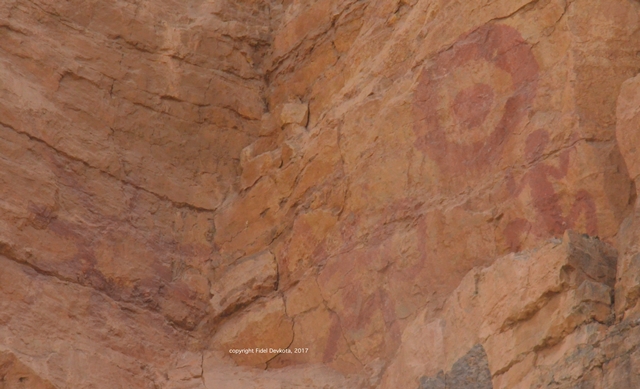
Fig. 39. A panel of figures comprised of a sunburst (left), standing anthropomorph (middle), circle with central dot (upper right), and squatting anthropomorphic figure (lower right). Ludak. Protohistoric period. Photo: Fidel Devkota.
The sunburst and squatting figures of these types were discussed in fig. 9. The other circular subject with the silhouetted central disc may also be a solar symbol. The middle pictograph could be another birthing figure but not many details are discernable in the photograph.
Conclusion
The discovery of rock art first in Kak Nyingba and recently in Shar-ri opens a new chapter in the study of prehistoric Mustang. The ochre pictographs in Kya and Ludak documented by Dr. Devkota are the first of their kind in Nepal. These discoveries have made available new resources that refine our understanding of the artistic and cultural world of Mustang before the introduction of Tibetan written records. These pictographs draw Lo Mustang into a broader cultural orbit which includes Upper Tibet, Spiti and Ladakh. The red ochre rock inscriptions of Kya are closely related to those in the Gnam-mtsho region, illustrating parallel processes in the spread of Buddhism, ca. the late 10th to the 13th centuries CE.
When the rock art of Mustang is compared to that of Upper Tibet, Spiti and Ladakh, numerous esthetic and technical affinities come to the fore, as reviewed in the second part of this article. All major subjects and themes and the techniques used to produce rock art in Lo Mustang are represented in other regions of the Western Tibetan Plateau (WTP). When seen in aggregate, the rock art of the various regions of the WTP defines an interwoven cultural fabric. This however does not signify that Mustang, Upper Tibet, Spiti, and Ladakh all had identical cultural parameters; i.e. customs, traditions, beliefs, languages, economic regimes, political structures, etc. In fact, regional differences in subject matter and artistic modes exhibited by the rock art record of the WTP suggest that this was not the case. While common cultural parameters on the WTP created an analogous rock art corpus in terms of content and form, dissimilar ones were responsible for contrasts in the rock art record.
The variable rock art record suggests that the WTP supported a mosaic of interrelated human groupings, distinguished by still not well understood territorial demarcations, social identities, cultural distinctions, and probably ethnical heterogeneity as well. The shared and differing aspects in the rock art of Mustang, Upper Tibet, Spiti, and Ladakh reflect a sphere of human relations in antiquity characterized by opposing impulses of consolidation and differentiation. As traced in the rock art record, human activities on the WTP evolved from the Late Bronze Age to the Vestigial period. In that time extraneous influences, incursions and countercurrents, as well as endogenous developments, transformed human behavior and technological outreach in ways we are only now beginning to understand. Thus, the ancient cultural tapestry of the WTP was not a static entity, nor did it completely cover the region. Dominant cultural inputs in Purig (Spu-rigs?) and Baltistan (Sbal-te), on the northwestern periphery of the Tibetan Plateau, include those originating farther west and north, having less to do with other portions of the WTP in the formative period of development.
With due caution, we might therefore analogize the prehistoric and early historic make-up of the WTP, from the contemporary and more recent historical picture. Mustang, Upper Tibet, Spiti, and Ladakh still have cultural and social variations that have helped engender strong regional identities (now often expressed in the dominant languages and the nationalistic vocabulary of the respective states to which they are joined). Nevertheless, there is also much that aligns all regions of the WTP and other parts of the Tibetan Plateau in the same cultural, linguistic and ethnical compass. Thus, what might be called today the Tibetan civilizational sphere or simply Tibetan civilization arose from a range of forces producing both convergent and divergent trends in the various regions of the WTP. Similarly, disparate forces in antiquity probably helped forge a civilizational sphere on the WTP with a complex cultural (and possibly linguistic and ethnic) composition. This civilization or multifaceted human order extended to other parts of the Tibetan Plateau as well, a discussion of which is beyond the confines of this article.
The rock art of Kya and Ludak is not only evidence of ancient civilization on the WTP, it also embodies locally based cultural patterns in Lo Mustang. As more archaeological information becomes available, the dynamic interplay between the global and local dimensions of human relations in Lo Mustang and other regions of the WTP in ancient times will become clearer.
Bibliography
Aldenderfer, Mark. 2013. “Variation in mortuary practice on the early Tibetan plateau and the high Himalayas”, in Journal of The International Association for Bon Research, vol. 1 (Inaugural Issue), pp. 293–318.
Aldenderfer, Mark and J. Eng. 2016. “Death and Burial at Two Ancient High Altitude Communities of Nepal”, in Companion to South Asian Prehistory: Archaeological and Bioarchaeological Perspectives. G. Schug and S. Walimbe (eds.) New York: Wiley-Blackwell.
Aldenderfer, Mark and Zhang Yinong. 2004. “The Prehistory of the Tibetan Plateau to the Seventh Century A.D.: Perspectives and Research from China and the West Since 1950”, in Journal of World Prehistory, vol. 18, no. 1, pp. 1–55. Springer: Netherlands.
Athans, Sandra K. 2014. Secrets of the Sky Caves: Danger and Discovery on Nepal’s Mustang Cliffs. Minneapolis: Millbrook Press.
Bellezza, John Vincent. In press-a. “Facsimiles of the Earliest Ritual Architecture in Tibet: A Comprehensive Survey of Stepped Shrines in the Rock Art of Upper Tibet”, in asianarts.com, written for the International Association of Tibetan Studies, Conference XIV, Bergen, June 19–25, 2016.
_____In press-b:. “Discerning Bon and Zhang Zhung on the Western Tibetan Plateau: Designing an archaeological nomenclature for Upper Tibet, Ladakh and Spiti Based on a study of cognate rock art”, for International Conference of Shang Shung Cultural Studies Beijing, September 18–21, 2015.
_____2017. “The Swastika, Stepped Shrine, Priest, Horned Eagle, and Wild Yak Rider: Prominent antecedents of Bon figurative and symbolic traditions in the rock art of Upper Tibet”, in Revue d’Etudes Tibétaines, no. 42, October 2017, pp. 5–38. Written for International Conference on Bon Studies hosted by the Shenten Dargye Ling Congregation, Blou, France, June 29–31, 2016.
_____2014a. Antiquities of Zhang Zhung: A Comprehensive Inventory of Pre-Buddhist Sites on the Tibetan Upland, Residential Monuments, vol. 1. Miscellaneous Series – 28. Sarnath: Central University of Tibetan Studies. Online version, 2011: Tibetan & Himalayan Library (THlib.org). http://www.thlib.org/bellezza
_____2014b. Antiquities of Zhang Zhung: A Comprehensive Inventory of Pre-Buddhist Sites on the Tibetan Upland, Ceremonial Monuments, vol. 2. Miscellaneous Series – 29. Sarnath: Central University of Tibetan Studies. Online version, 2011: Tibetan & Himalayan Library (THlib.org): http://www.thlib.org/bellezza
_____2014c. The Dawn of Tibet: The Ancient Civilization on the Roof of the World. Lanham: Rowman & Littlefield.
_____2013. Death and Beyond in Ancient Tibet: Archaic Concepts and Practices in a Thousand-Year-Old Illuminated Funerary Manuscript and Old Tibetan Funerary Documents of Gathang Bumpa and Dunhuang. Philosophisch-Historische Klasse Denkschriften, vol. 454. Wien: Verlag der Österreichischen Akademie der Wissenschaften.
_____2008. Zhang Zhung: Foundations of Civilization in Tibet. A Historical and Ethnoarchaeological Study of the Monuments, Rock Art, Texts and Oral Tradition of the Ancient Tibetan Upland. Philosophisch-Historische Klasse Denkschriften, vol. 368. Wien: Verlag der Österreichischen Akademie der Wissenschaften.
_____2005. Calling Down the Gods: Spirit-Mediums, Sacred Mountains and Related Bon Textual Traditions in Upper Tibet, Tibetan Studies Library, vol. 8. Leiden: Brill.
_____2004. “Metal and Stone Vestiges: Religion, Magic and Protection in the Art of Ancient Tibet”, in Asian Art Online Journal.
http://www.asianart.com/articles/vestiges/index.html
_____2001. Antiquities of Northern Tibet: Archaeological Discoveries on the High Plateau. (Findings of the Changthang Circuit Expedition, 1999). Delhi: Adroit.
_____2000. “Bon Rock Paintings at gNam mtsho: Glimpses of the Ancient Religion of Northern Tibet”, in Rock Art Research, vol. 17 (1), pp. 35–55. Melbourne: AURA and IFRAO.
_____ 1997. Divine Dyads: Ancient Civilization in Tibet. Dharmasala: Library of Tibetan Works and Archives.
Darnal, Prakash. 2008. “Reconnaissance of Caves in Upper Lo Mustang”, in Ancient Nepal, vol. 166, pp. 1–31.
Devers Quentin. 2014. “Les fortifications du Ladakh de l’Âge du Bronze à la perte d’indépendance (1683-1684 d.n.è)”, Ph.D. dissertation. Paris: École Pratique des Hautes Études.
Devers, Quentin / Bruneau, Laurianne / Vernier, Martin. 2015. “An archaeological survey of the Nubra Region (Ladakh, Jammu and Kashmir, India)”, in Études mongoles & sibériennes, centrasiatiques & tibétaines, no. 46. Paris: EMSCAT.
Devkota, Fidel. 2017. Climate Vulnerability and Adaptation to Climate Impacts in the Himalayan Region of Nepal. PhD Thesis. Freie Universität, Berlin.
Dhungel, Ramesh K. 2002. The Kingdom of Lo (Mustang). A Historical Study. Kathmandu: Tashi Gephel Foundation.
Francke, August Hermann. 1995. A History of Western Tibet: One of the Unknown Empires. New Delhi: Asian Educational Service.
_____1926. The Antiquities of Indian Tibet. Vol. 1 & 2. New Delhi: S Chand & Co.
Gleba, Margarita / Vanden Berghe, Ina / Aldenderfer, Mark. 2016. “Textile Technology in Nepal in the 5th-7th centuries CE: The Case of Samdzong”, in Science & Technology of Archaeological Research (STAR), vol. 2 (no. 1), pp. 25–35 (http://www.tandfonline.com/doi/full/10.1080/20548923.2015.1110421)
Haarh, Erik. 1969. The Yar-luṇ Dynasty: a study with particular regard to the contribution of myths and legends to the history of Ancient Tibet and the origin and nature of its kings. Copenhagen: G.E.C. Gad’s Forlag.
Jackson, David P. 1978. “Notes on the history of Se-Rib, and nearby places in the Upper Kali Gandaki Valley.”, in Kailash, vol. 6 (no. 3), pp. 195–227.
_____1976. “The early history of Lo (Mustang) and Ngari.”, in Contributions to Nepalese Studies, vol. 4 (no. 1), pp. 39–56.
Jacobson, Esther. 2015: The Hunter, the Stag, and the Mother of Animals: Image, Monument and Landscape in Ancient North Asia. New York: Oxford University Press.
_____1997. “The ‘bird woman,’ the ‘birthing woman’, and the ‘woman of the animals’: A consideration of the female image in petroglyphs of ancient Central Asia”, in Arts Asiatiques, vol. 52, pp. 37–59. Paris: École française d’Extrême-Orient.
Karmay, Samten G. 2003. “Light, Ray, Frost and Dew: Formation of the World” in Cosmogony and the Origins, Lungta, no. 16, pp. 7–10. Dharamsala: Amnye Machen Institute.
_____1998. The Arrow and the Spindle: Studies in History, Myths, Rituals and Beliefs in Tibet. Kathmandu: Mandala Book Point.
Kind, Marietta. 2012. The Bon Landscape of Dolpo: Pilgrimages, Monasteries, Biographies and the Emergence of Bon. Frankfurt: Peter Lang.
Kramer, Jowita. 2008. A Noble Abbot from Mustang: Life and works of Glo-bo Mkhan-chen (1456-1532). Vienna: Arbeitskreis für Tibetische und Buddhistische Studien, Universität Wien.
Mishra, Tara Nanda. “The Archaeological Research in the High Mountains of Mustang District: An Assessment of the Situation.” Ancient Nepal, vol. 136 (Mustang Special), pp. 147–160. Kathmandu: The Department of Archaeology.
Namkhai Norbu. 1995. Drung, Deu and Bön. Narrations, Symbolic languages and the Bön tradition in Ancient Tibet (trans. A. Clemente and A. Lukianowicz). Dharamsala: Library of Tibetan Works and Archives.
Pohle, Perdita. 2000. Historisch-Geographische Untersuchungen im Tibetischen Himalaya. Felsbilder und Wüstungen als Quelle zur Besiedlungs- und Kulturgeschichte von Mustang (Nepal). Abbildungsband, vol. 2. Giessener Geographische Schriften. Giessen: Selbstverlag des Instituts für Geographie der Justus-Liebig Universität.
_____2003. “Petroglyphs and Abandoned sites in Mustang a Unique Source for Research in Cultural History and Historical Geography”, in Ancient Nepal, vol. 153, pp. 1–14. Kathmandu: The Department of Archaeology.
http://himalaya.socanth.cam.ac.uk/collections/journals/ancientnepal/pdf/ancient_nepal_153_01.pdf
Ramble, C., and S. Seeber. 1995. “Dead and living settlements in the Shod-yul of Mustang”, in Ancient Nepal, vol. 138, pp. 107–130.
Ramble, Charles. 2004. “The secular surroundings of a Bonpo ceremony: Games, popular rituals and economic structures in the mDos rgyab of Klu-brag monastery (Nepal)”, in New Horizons in Bon Studies. Samten G. Karmay & Yasuhiko Nagano (eds.), pp. 289-316. New Delhi: Saujanya Publications.
Ramble, Charles. 2007. The Navel of the Demoness. Oxford: Oxford University Press.
Rao, S. K. Ramchandra. 2009. Salagram-Kosha (Vol. I & II). New Delhi: Sri Satguru Publications. India.
Samuel, Geoffrey. 2004. “The Indus Valley Civilization and Early Tibet.”, in New Horizons in Bon Studies. Samten G. Karmay & Yasuhiko Nagano (eds.), pp. 651–670. New Delhi: Saujanya Publications.
Snellgrove David, and Hugh Richardson. 2003. A Cultural History of Tibet. Bangkok: Orchid.
Sharma, Prayagraj and Jagatman Gurung. 1989. Blo/Mustang ko Sanskriti Sampada (The Cultural Heritage of blo/Mustang). Kathmandu: Institute of Nepal and Asian Studies (INAS).
Tucci, Giuseppe. 1956. Preliminary Report on Two Scientific Expeditions in Nepal (Vol. 1). Roma: Istituto Italiano per Il Medio Ed Estremo Oriente.
Vernier, Martin and Bruneau Laurianne. 2017. “Evidence of Human Presence in the Himalayan Mountains: New Insights from Petroglyphs”, in Bird Migration Across the Himalayas: Wetland Functioning amidst Mountains and Glaciers (eds. H. H. T. Prins and T. Namgail), pp. 319–332. Cambridge: Cambridge University Press.
Vital, Roberto. 2012. A Short History of Mustang (10th -15th century). Dharmasala: Amnye Machen Institute.
_____2003. “Nomads of Byang and mNga’-ris-smad: a historical overview of their interaction in Gro-shod, ‘Brong-pa, Glo-bo and Gung-thang from the 11th to the 15th Century.” The History of Tibet. Alex McKay (ed.), pp. 90–105. London: Routledge Curzon.
_____1997. “Nomads of Byang and mNga’-ris-smad: a historical overview of their interaction in Gro-shod,’Brong-pa, Glo-bo and Gung-thang from the 11th to the 15th Century.” Tibetan Studies: Proceedings of the 7th Seminar of the International Association for Tibetan Studies (Vol. 2). Helmut Krasser, Michael T. Much, Ernst Steinkeller and Helmut Tauscger (eds.), pp. 1030–1036. Vienna: Verlag ÖAW.
Next month: Both ancient Ladakh and Upper Tibet!